Science Meeting Documents
2025 Science and Applications Team 3 Meeting
2023 Science and Applications Team Meeting
2022 Ocean Sciences Meeting
2021 Science and Applications Team Meeting
2020 Science and Applications Team Meeting
NASA/IOCCG Aquatic Primary Productivity Workshop
2018 Science Team Meeting
2017 Science Team Meeting
2016 NASA Ocean Color Research Team Meeting
2016 Ocean Sciences Meeting
2016 Science Team Meeting
2015 Science Team Meeting
2012 Science Definition Team Meeting
2011 Science Definition Team Meeting
2025 Science and Applications Team 3 Meeting
February 18 - February 21, 2025New York, NY USA
Documents (23)

A Phytoplankton Carbon Algorithm for PACE OCI Retrievals
Fox, J., Graff, J., and Kramer, S. (20-Feb-25) 
Advanced Air Quality Forecasting Through Coupled Data Assimilation of Hyperspectral PACE Aerosol Retrievals and All-Sky Radiances from Multiple Satellite-Based Sensors
Ha, S. (20-Feb-25) 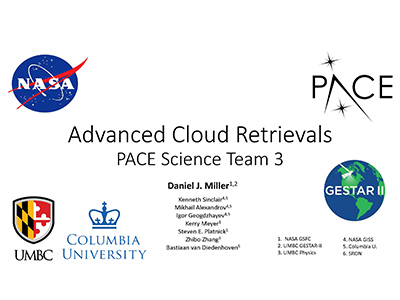
Advanced Cloud Retrievals
Miller, D.J., Sinclair, K., Alexandrov, M., Geogdzhayez, I., Meyer, K., Platnick, S.E., Zhang, Z., and van Diedenhoven, B. (20-Feb-25) 
Advanced, High Spatial Resolution PACE OCI Nitrogen Dioxide (NO2) Product and Potential Applications
Fasnacht, Z., Joiner, J., Bucsela, E., Bandel, M., Marchenko, S., Lamsal, L., Li, C., and Krotkov, N. (20-Feb-25) 
BAYFLUOR: A Bayesian Full-Spectrum Fluorescence Retrieval (for PACE)
Frankenberg, C., Sanghavi, S., Erickson, Z., Luis, K., and Gierach, M. (20-Feb-25) 
Current and Future Scenarios of Phytoplankton Community Composition (PCC) and Harmful Algal Blooms in the Northern Gulf of Mexico
Liu, B., Stauffer, B., D'Sa, E., Baustian, M., Liang, J., and Zhang, S. (20-Feb-25) 
Field Campaigns to Enable Global, Frequent Ecological Observations from Space: FILLING LAND AND OCEAN KNOWLEDGE GAPS
Schimel, D. (20-Feb-25) 
Fresh and Coastal Water Product Refinement and Extension for PACE
O'Shea, R., Zhai, P., Smith, B., Hyde, K., Vandermeulen, R., Wolny, J., Brewin, R., Gidudu, A., Saranathan, A., Ashapure, A. and Wainwright, W. (20-Feb-25) 
Getting Over the Finish Line
Remer, L., Torres, O., Levy, R.C., Hsu, N.C., Mattoo, S., Jethva, H., Shi, Y.R., and Kim, W.V. (20-Feb-25) 
MAIAC-OCI: Processing Over Land
Lyapustin, A., Choi, M., Wang, Y., and Korkin, S. (20-Feb-25) 
Maintenance and Development of Radiative Transfer and Remote Sensing Algorithms for the PACE Instruments
Zhai, P., Hu, Y., and Aryal, K. (20-Feb-25) 
Mapping Floating Matters in the PACE and AI Era
Hu, C., Barnes, B., and Qi, L. (20-Feb-25) 
PACE Mission Updates (including Instruments Update) and Science Data Segment Overview
Werdell, J. (18-Feb-25) 
Phytoplankton Pigments & Diatom Biomass from PACE
Chase, A. and Gaube, P. (20-Feb-25) 
Phytoplankton Pigments from Hyperspectral Rrs: The Spectral Derivatives Pigment (SDP) Model for PACE
Siegel, D., Maritorena, S., and Kramer, S. (20-Feb-25) 
PolArimetric RetrievAls of Biomass-burning aerosols Over LAnd (PARABOLA)
Chowdhary, J., Stamnes, S., Moosmüller, H., Ottaviani, M., and Mezuman, K. (20-Feb-25) 
Polarimetric Retrievals of Surface and Aerosol Parameters in Polar Regions from PACE Multi-Sensor Observations
Ottaviani, M., Chowdhary, J., Geogdzhayev, I., Alexander, P., Thompson, D., van Diedenhoven, B., Hasekamp, O., Martins, V., Chen, N., Lyapustin, A., Remer, L., Tsigaridis, K., Jin, Z., Tedesco, M., Lelli, L., and Kokhanovsky, A. (20-Feb-25) 
Refinement and Advancement of the ZTT Semi-Analytic Algorithm for PACE
Moore, T., Twardowski, M., Tonizzo, A., Wistort, Z., and Coco, E. (20-Feb-25) 
Retrieve the Properties of Above-Cloud Smoke Aerosols and Their Spectrally-Resolved Direct Effects in SE Atlantic Region from PACE Observatory
Zhang, Z., Miller, D., and Meyer, K. (20-Feb-25) 
Spatiotemporally-Based PACE Algorithms for Improved Optically Shallow Water Retrievals
Barnes, B., Hu C., Xie, Y., and Xue, C. (20-Feb-25) 
Terrestrial Ecosystem Productivity and Biodiversity from PACE
Huemmrich, F. (20-Feb-25) 
Understanding the Environmental Drivers of Sargassum
Bell, T. and Houskeeper, H. (20-Feb-25) 
Updates from our International Partners: EUMETSAT
Kwiatkowska, E. and Brando, V. (20-Feb-25) 2023 Science and Applications Team Meeting
February 26 - March 1, 2023San Diego, CA USA
Documents (22)

Code Delivery, Co-Development, and the Year of Open Science @NASA
Carroll, I. and Craig, S. (01-Mar-23) 
Developing a PACE Hyperspectral Bio-Optical Algorithm Framework for Detection of Freshwater Harmful Algal Blooms
Sayers, M. and Shuchman, R. (27-Feb-23). Click here to view this presentation with audio. 
Development of Robust Spectral Derivative Algorithms for Phytoplankton Pigment Concentrations on Local to Global Scales
Siegel, D. (27-Feb-23). Click here to view this presentation with audio. 
Hyperspectral algorithms for PACE OCI atmospheric correction and UV penetration using Ozone Monitoring Instrument (OMI) and TROPOspheric Monitoring Instrument (TROPOMI)
Krotkov, N. (27-Feb-23). Click here to view this presentation with audio. 
MAIAC Aerosol Retrieval and Hyperspectral Atmospheric Correction of TROPOMI Data
Go, S. and Lyapustin, A. (27-Feb-23). Click here to view this presentation with audio. 
Maximizing Utility of PACE in Coastal and Major Freshwater Ecosystems: Advancing Science for Societal Benefits
Pahlevan, N. (27-Feb-23). Click here to view this presentation with audio. 
Next generation algorithms based on PACE capabilities to obtain inherent optical properties of seawater associated with phytoplankton, nonalgal particles, and colored dissolved organic matter
Stramski, D. (27-Feb-23). Click here to view this presentation with audio. 
Ocean Surface Refractive Index retrieval and Oil Spill detection for PACE
Ottaviani, M. (27-Feb-23). Click here to view this presentation with audio. 
PACE measurements of Sargassum macroalgae
Hu, C. (27-Feb-23) 
PACE polarimetric aerosol and ocean color remote sensing: HARP2 L2 retrievals updates
Gao, Meng (27-Feb-23). Click here to view this presentation with audio. 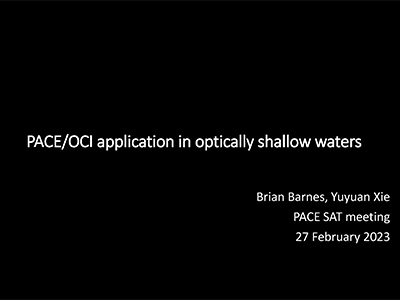
PACE/OCI application in optically shallow waters
Barnes, B. (27-Feb-23). Click here to view this presentation with audio. 
Phytoplankton Algorithms and Data Assimilation: Preparing a Pre-launch Path to Exploit PACE Spectral Data
Rousseaux, C. (27-Feb-23). Click here to view this presentation with audio. 
Phytoplankton communities from PACE: toward a global diatom product
Chase, A. and Gaube, P. (27-Feb-23). Click here to view this presentation with audio. 
Radiative products for the PACE era
Boss, E. and Frouin, R. (27-Feb-23). Click here to view this presentation with audio. 
Remote sensing of cloud properties using PACE SPEXone and HARP-2
van Diedenhoven, B. (27-Feb-23). Click here to view this presentation with audio. 
Semi-Analytical models and inversion algorithms for PACE
Twardowski, M. and Moore, T. (27-Feb-23). Click here to view this presentation with audio. 
Support for the PACE OCI cloud products
Meyer, K. (27-Feb-23). Click here to view this presentation with audio. 
Terrestrial Ecology Products from PACE
Huemmrich, F. (27-Feb-23) 
The PACE Postlaunch Airborne eXperiment: PACE-PAX
Knobelspiesse, K. (01-Mar-23) 
The PACE-MAPP algorithm
Stamnes, D. (27-Feb-23). Click here to view this presentation with audio. 
Theoretical support for developing the PACE atmospheric correction algorithm: radiative transfer and polarimetric retrieval of aerosol and ocean color properties: Updates
Zhai, P. and Hu, Y. (27-Feb-23). Click here to view this presentation with audio. 
Using Multi-angle Polarimetry to Derive χ factor and Improve BRDF Correction for PACE’s OCI
Zhang, X. and Gray, D. (27-Feb-23). Click here to view this presentation with audio. 2022 Ocean Sciences Meeting
February 24 - March 4, 2022Virtual
Documents (14)
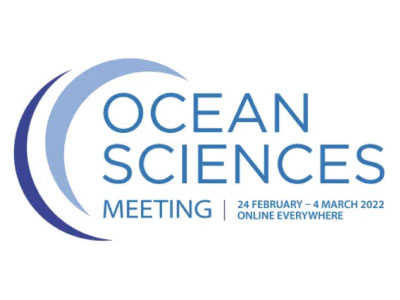
Atmospheric Correction for Ocean Retrievals from the PACE Observatory
Ibrahim, A. (03-Mar-22). NASA's Plankton, Aerosol, Cloud, ocean Ecosystem (PACE) is a climate continuity mission that aims to extend the high-quality ocean ecological and biogeochemical, clouds, and aerosols data records begun by NASA in the 1990s. 
Bio-optical Algorithm Validation in the PACE Era: Farewell to the Scatter Plot?
McKinna, L. (02-Mar-22). As the launch NASA'S Plankton, Aerosol, Cloud, ocean Ecosystem (PACE) mission approaches, we must prepare to routinely validate bio-optical data products at hundreds of wavelength. 
Chasing Carbon in North Atlantic
Cetinić, I. and Soto-Ramos, I. (01-Mar-22). How crazy do you have to be to chase carbon in the North Atlantic in the middle of the storms with three ships and a bunch of autonomous vehicles, and then try not to run anything over and then do it while finding an eddy. 
Joint Town Hall for NASA Hyperspectral Aquatic Missions PACE, GLIMR, and SBG
Turpie, K. (24-Feb-22). NASA is developing three new imaging spectroscopy missions for this decade. This town hall provides an update on each mission and a panel-led community discussion regarding cross-mission collaboration and the potential of combined observations as a constellation. 
Keeping PACE with the NASA Plankton, Aerosol, Cloud, ocean Ecosystem Mission
Werdell, J. (03-Mar-22). This presentation will showcase the current status of the NASA Plankton, Aerosol, Cloud, ocean Ecosystem (PACE) mission. 
Machine Learning Approaches for Predicting Phytoplankton Community Composition from Ocean Color
Craig, S. (03-Mar-22). In preparation for the upcoming PACE and GLIMR missions, we are developing a Bayesian machine learning (ML) approach to use hyperspectral ocean color (OC) measurements & ecological principles to accurately describe phytoplankton community composition. 
Multidisciplinary Insights into Pathways of Carbon Export [Session]
Cetinić, I. (03-Mar-22). This session welcomes research topics employing ecological, biogeochemical and physical observations aimed at improving quantification and understanding of biologically-mediated carbon fluxes in the ocean. 
NASA PACE Mission: Advanced Hyperspectral and Multi-Angular Polarimetric Satellite Observations for Ocean Science, Conservation, and Management Applications
Urquhart, E. and Sadoff, N. (28-Feb-22). This poster provides case studies and Early Adopter projects where PACE is enabling the continuation of heritage MODIS and VIIRS visible, near-infrared, and shortwave-infrared data products at 1 km resolution, as well as producing new hyperspectral and multi-angular polarimetric advanced data products not possible with MODIS and VIIRS due to their design and technological limits. 
NOMAD v3.0: Supporting PACE Mission for Validation and Algorithm Development
Sanjuan Calzado, V. (01-Mar-22). PACE, Plankton, Aerosol, Cloud, ocean Ecosystem is a new NASA ocean color mission which aims to extend ocean color, aerosol, and cloud data records with advanced instrumentation surpassing previous and current missions. 
Pursuing Data-Driven Water Quality Monitoring and Forecasting via the NASA PACE Applications Program
Sadoff, N. and Urquhart, E. (04-Mar-22). This talk provides an overview to PACE Applications and PACE data related to water quality monitoring and forecasting, with best practices and lessons learned offered for enhanced decision-making activities, considerations for new observations and data products, as well as insights for the UN Sustainable Development Goals (SDG-6 (Clean Water), SDG-14 (Life Below Water), and SDG-17 (Partnerships), and the Group on Earth Observations (GEO) AquaWatch Initiative. 
Success Stories of APPS, Trainings and Engagement Getting Near Real Time Data to Water Managers Monitoring for Cyanbacteria Blooms
Seegers, B. (28-Feb-22). Cyanobacteria blooms are a water quality issue that impacts ecosystem and human health, recreational opportunities, and local economies. Therefore, there is interest in monitoring for these harmful cyanobacteria events. 
Training Data for Phytoplankton Community Characterization from Ocean Color
Carroll, I. (03-Mar-22). CE data will drive new machine learning (ML) applications, including the model we are developing to predict phytoplankton community composition (PCC) from hyperspectral ocean color. 
Ushering in a New Era of Hyperspectral and Polarimetric Radiometry for Remote Sensing of Global Ocean Ecosystems [Session]
Werdell, J., McKinna, L., Cetinić, I., and Dierssen, H. (28-Feb-22). We welcome research that challenges existing paradigms in our understanding of the capabilities of the remote sensing observation of the global ocean, particularly with a broad eye on the use of hyperspectral ocean color and multi-angle polarimetric observations. 
Why PACE is an Atmospheric Mission and Why it Matters to You, an Ocean Scientist
Remer, L. (28-Feb-22). The Plankton, Aerosol, Clouds, ocean Ecology (PACE) mission will push satellite observations of ocean biology to the next level. However, half of PACE's scientific potential is understanding the atmosphere. 2021 Science and Applications Team Meeting
October 5-8, 2021Groton, CT USA
Documents (42)
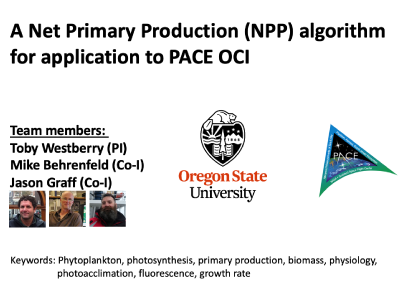
A Net Primary Production (NPP) Algorithm
for Application to PACE OCI
Westberry, T. (06-Oct-21) 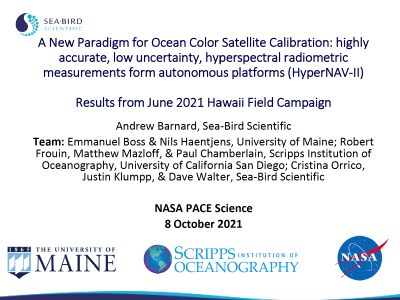
A New Paradigm for Ocean Color Satellite Calibration: Highly Accurate, Low Uncertainty, Hyperspectral Radiometric
Measurements from Autonomous Platforms (HyperNAV-II)
Barnard, A. (08-Oct-21) 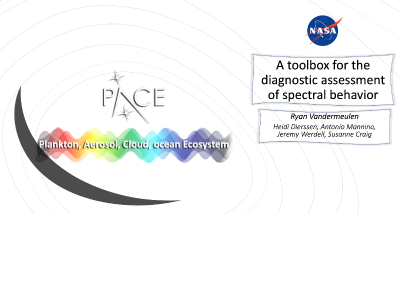
A Toolbox for the Diagnostic Assessment of Spectral Behavior
Vandermeulen, R. (06-Oct-21). This PowerPoint file contains audio and will download when clicked. View this presentation without audio. 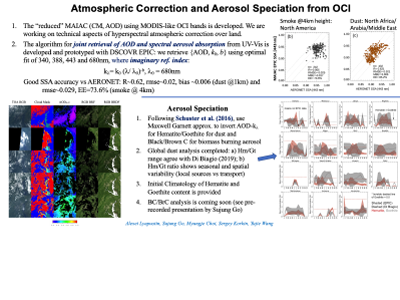
Atmospheric Correction and Aerosol Speciation from OCI
Lyapustin, A. (06-Oct-21) 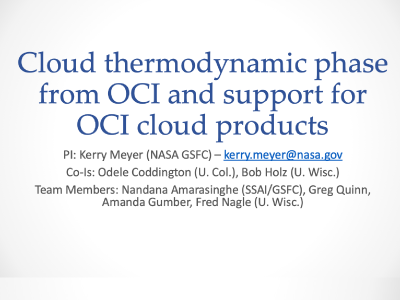
Cloud Thermodynamic Phase from OCI and Support for OCI Cloud Products
Meyer, K. (06-Oct-21) 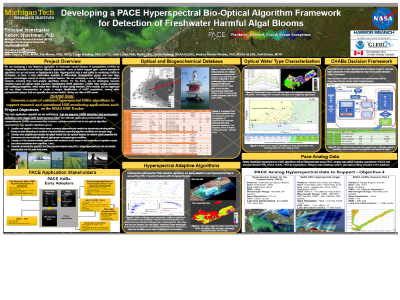
Developing a PACE Hyperspectral Bio-Optical Algorithm Framework for Detection of Freshwater Harmful Algal Blooms
Sayers, M. (06-Oct-21) 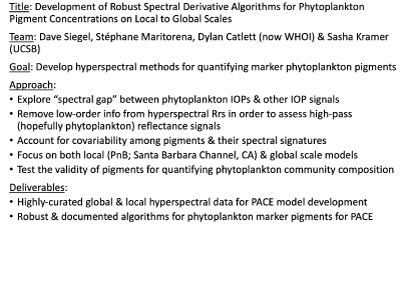
Development of Robust Spectral Derivative Algorithms for Phytoplankton Pigment Concentrations on Local to Global Scales
Siegel, D. (06-Oct-21). View the file that accompanies this presentation. 
FastMAPOL: An Efficient Multi-angle Polarimetric Algorithm for Simultaneous Aerosol and Ocean Color Retrievals Powered by Deep Learning
Gao, M. (06-Oct-21) 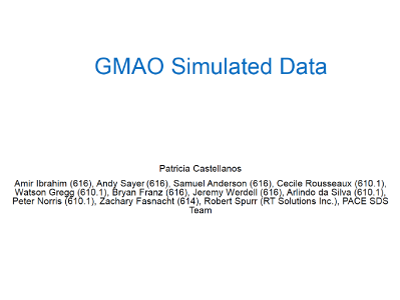
GMAO Simulated Data
Castellanos, P. (08-Oct-21) 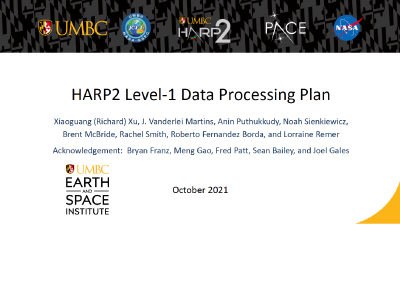
HARP2 Level 1 Data Processing Plan
Xiaoguang, R. (06-Oct-21) 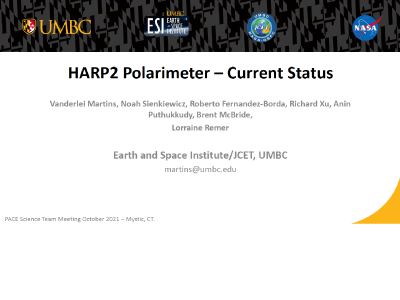
HARP2 Polarimeter Current Status
Martins, V. (06-Oct-21) 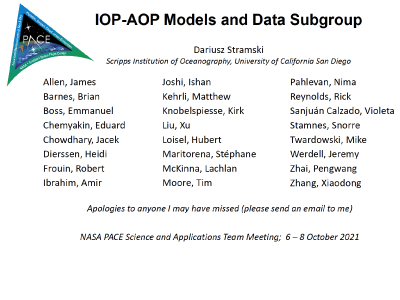
IOP-AOP Models and Data Subgroup
Stramski, D. (07-Oct-21) 
Machine Learning Approaches for Predicting Phytoplankton Community Composition (PCC) from Ocean Color
Craig, S. (06-Oct-21). Click here to view this presentation with audio. 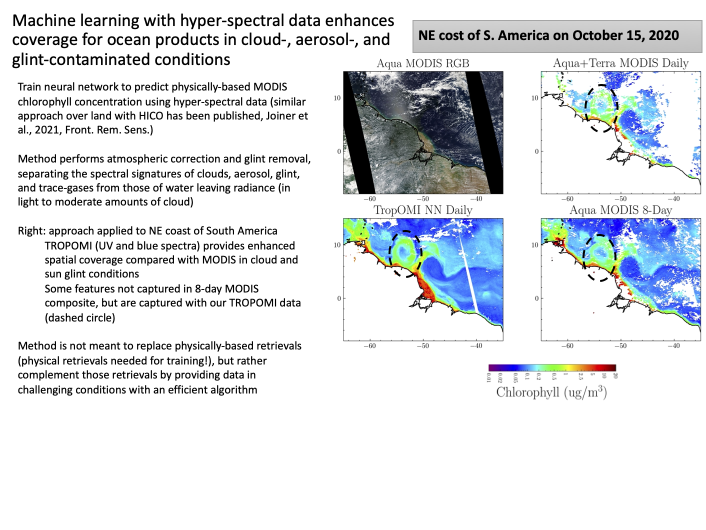
Machine Learning with Hyper-spectral Data Enhances Coverage for Ocean Products in Cloud-, Aerosol-, and Glint-contaminated Conditions
Krotkov, N. (06-Oct-21) 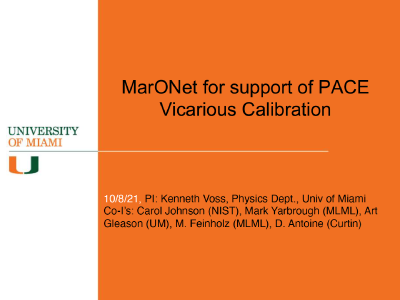
MarONet for support of PACE Vicarious Calibration
Voss, K. (08-Oct-21) 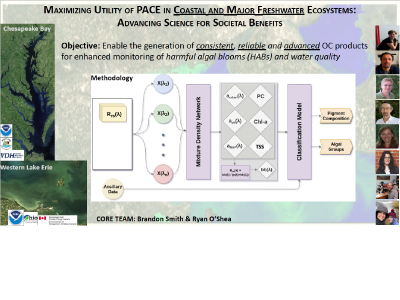
Maximizing Utility of PACE in Coastal and Major Freshwater Ecosystems: Advancing Science for Societal Benefits
Pahlevan, N. (06-Oct-21) 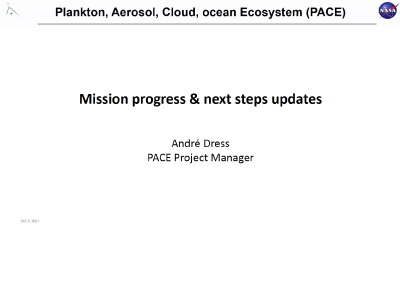
Mission Progress & Next Steps Updates
Dress, A. (06-Oct-21). View the movies that accompany this presentation: Mission summary 1 | Mission summary 2
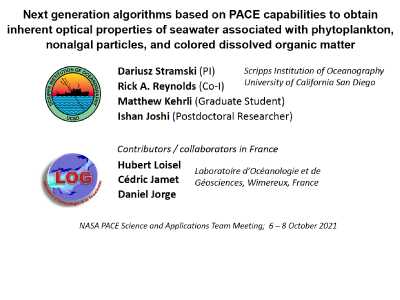
Next Generation Algorithms Based on PACE Capabilities to Obtain Inherent Optical Properties of Seawater Associated with Phytoplankton, Nonalgal Particles, and Colored Dissolved Organic Matter
Stramski, D. (06-Oct-21) 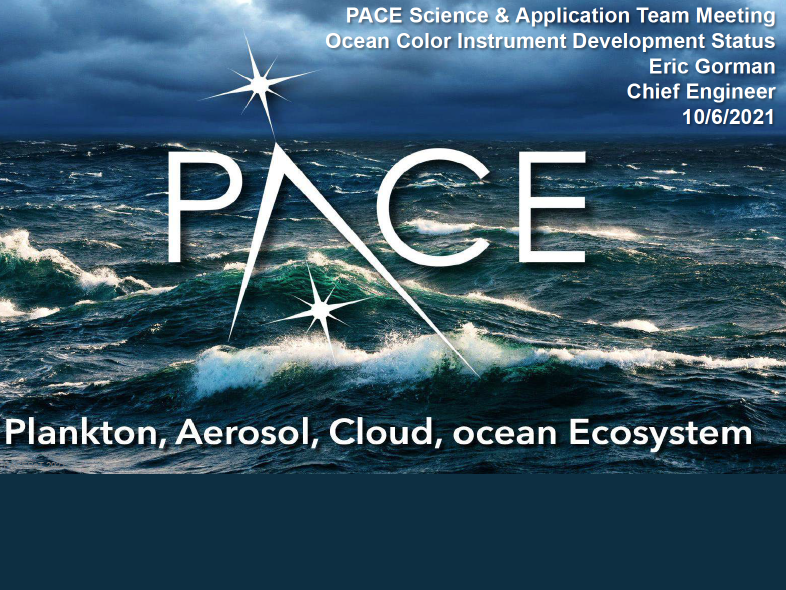
Ocean Color Instrument Development Status
Gorman, E. (06-Oct-21). View the movies that accompany this presentation:
Time to cut metal 1 |
Time to cut metal 2 |
Time to cut metal 3 |
Optical module assembly |
Thermal vacuum test preparation |
Covid 19 restart activities |
Prototype test build |
Solar calibration assembly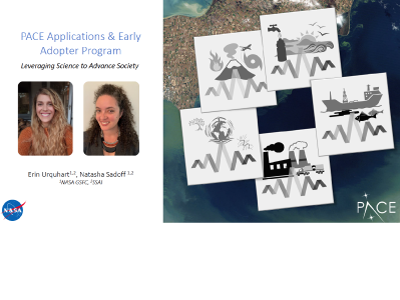
PACE Applications & Early Adopter Program
Urquhart, E. (07-Oct-21) 
PACE Clouds Working Group
van Diedenhoven, B. (08-Oct-21) 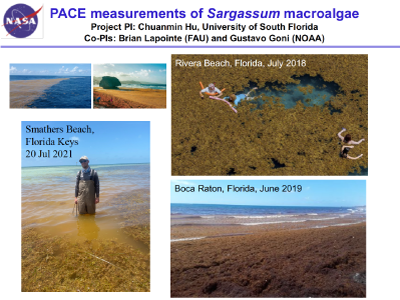
PACE Measurements of Sargassum Macroalgae
Hu, C. (06-Oct-21) 
PACE Multi-angle Polarimetry Update
Knobelspiesse, K. (07-Oct-21) 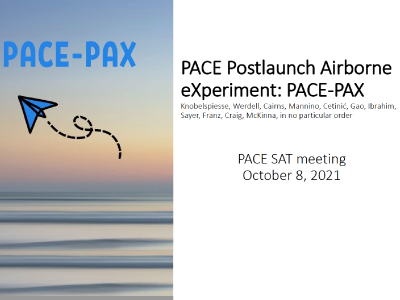
PACE Postlaunch Airborne eXperiment: PACE PAX
Knobelspiesse, K. (08-Oct-21). View the files that accompany this presentation here:
Field Campaign
and
Validation Traceability Matrix (XLSX, 5.2 MB).

PACE Programmatic Update
Lorenzoni, L. (06-Oct-21) 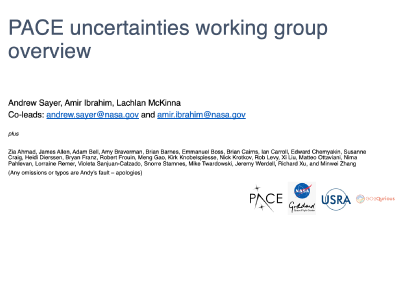
PACE Uncertainties Working Group
Overview
Sayer, A. (06-Oct-21) 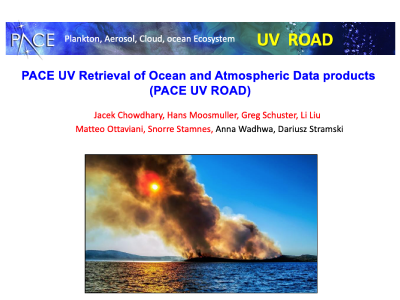
PACE UV Retrieval of Ocean and Atmospheric Data Products (PACE UV ROAD)
Chowdhary, J. (06-Oct-21) 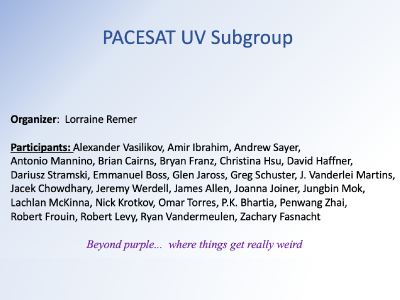
PACESAT UV Subgroup
Remer, L. (07-Oct-21) 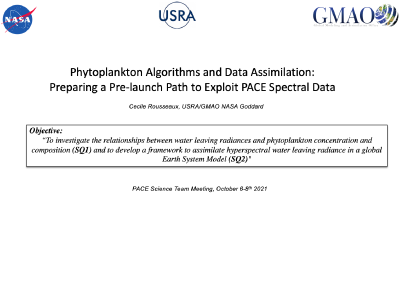
Phytoplankton Algorithms and Data Assimilation: Preparing a Pre-launch Path to Exploit PACE Spectral Data
Rousseaux, C. (06-Oct-21) 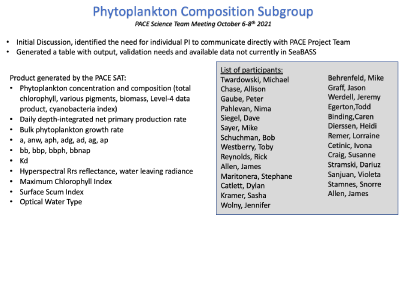
Phytoplankton Composition Subgroup
Rousseaux, C. (08-Oct-21) 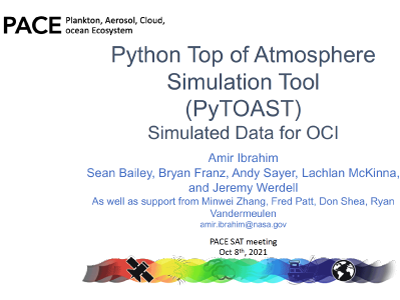
Python Top of Atmosphere Simulation Tool (PyTOAST) - Simulated Data for OCI
Ibrahim, A. (08-Oct-21) 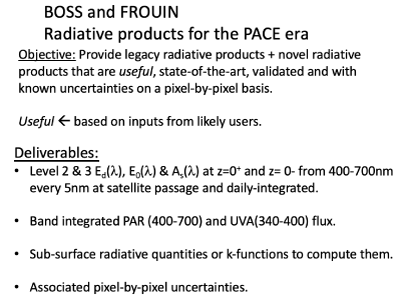
Radiative Products for the PACE Era
Boss, E. (06-Oct-21) 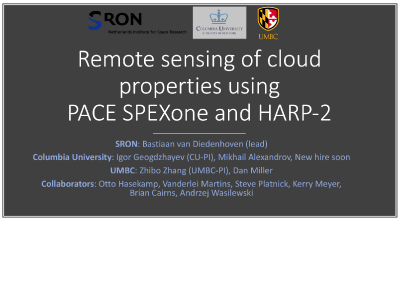
Remote Sensing of Cloud Properties Using PACE SPEXone and HARP-2
van Diedenhoven, B. (06-Oct-21) 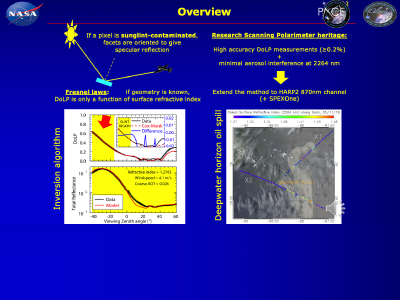
Retrievals of the Ocean Surface Refractive Index
Ottaviani, M. (06-Oct-21) 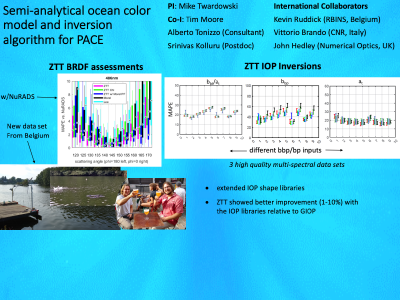
Semi-analytical Ocean Color Model and Inversion Algorithm for PACE
Twardowski, M. (06-Oct-21) 
Spectral Matching Inversion Algorithms for PACE Application in Optically Shallow Waters:
An Assessment Using HICO and PRISM Data
Barnes, B. (06-Oct-21) 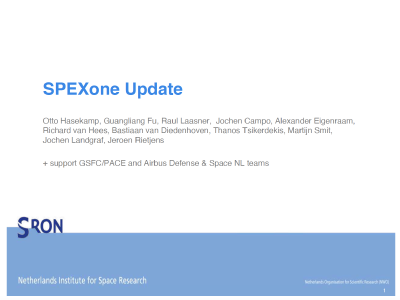
SPEXone Update
Hasekamp, O. (06-Oct-21) 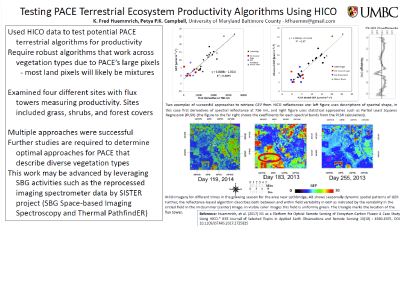
Testing PACE Terrestrial Ecosystem Productivity Algorithms Using HICO
Huemmrich, F. (06-Oct-21) 
The PACE MAPP Algorithm
Stamnes, S. (06-Oct-21) 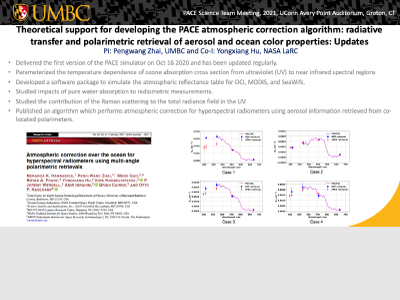
Theoretical Support for Developing the PACE Atmospheric Correction Algorithm: Radiative Transfer and Polarimetric Retrieval of Aerosol and Ocean Color Properties: Updates
Zhai, P. (06-Oct-21) 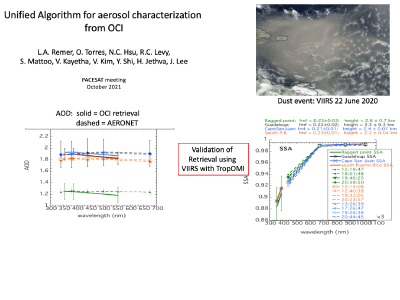
Unified Algorithm for Aerosol Characterization from OCI
Remer, L. (06-Oct-21) 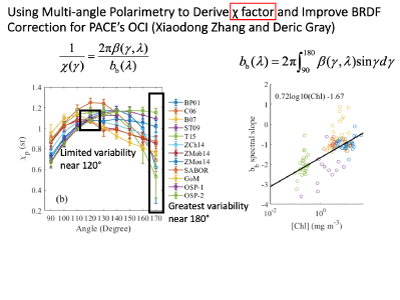
Using Multi-angle Polarimetry to Derive χ Factor and Improve BRDF Correction for PACE’s OCI
Zhang, X. (06-Oct-21) 2020 Science and Applications Team Meeting
June 2-3, 2020Online
Documents (29)
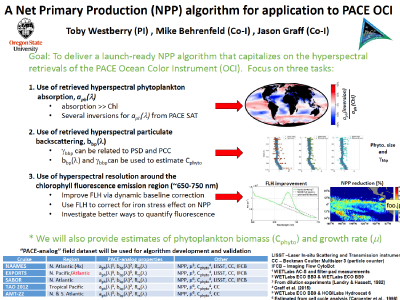
A Net Primary Production (NPP) Algorithm for Application to PACE OCI
Westberry, T., Behrenfeld, M., and Graff, J. (03-Jun-20) 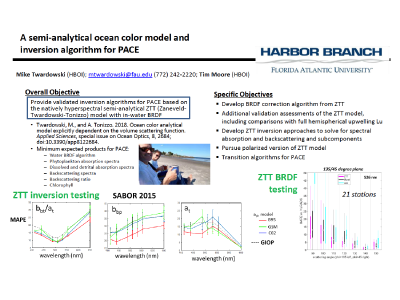
A Semi-Analytical Ocean Color Model and Inversion Algorithm for PACE
Twardowski, M. and Moore, T. (03-Jun-20) 
Cloud Products from the PACE Ocean Color Imager
Meyer, K., Ackerman, S., Coddington, O., Holz, R., and Platnick, S. (03-Jun-20) 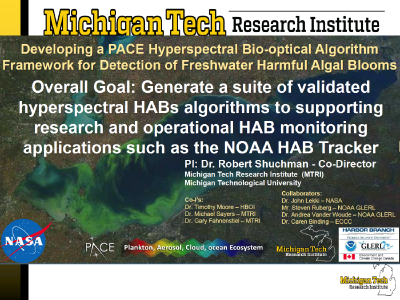
Developing a PACE Hyperspectral Bio-Optical Algorithm Framework for Detection of Freshwater Harmful Algal Blooms
Shuchman, R., Fahnenstiel, G., Moore, T., and Sayers, M. (03-Jun-20) 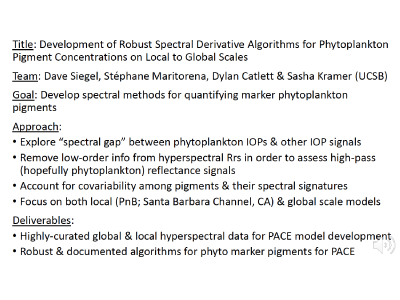
Development of Robust Spectral Derivative Algorithms for Phytoplankton Pigment Concentrations on Local to Global Scales
Siegel, D. and Maritorena, S. (03-Jun-20) 
Going Beyond Chlorophyll-A: Developing Phytoplankton Community Composition Algorithms from Hyperspectral Remote Sensing Reflectances
Gaube, P. (03-Jun-20) 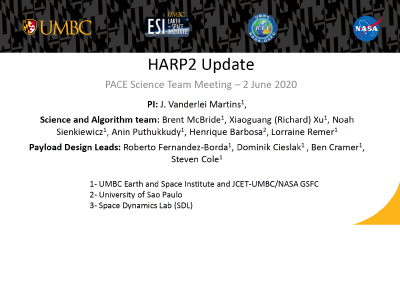
HARP2 Update
Martins, J.V. (02-Jun-20) 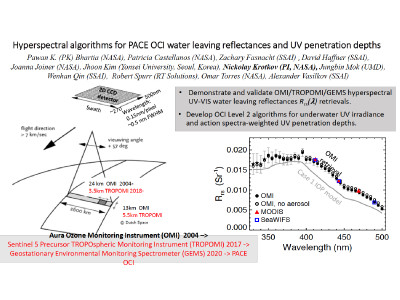
Hyperspectral Algorithms for PACE OCI Water Leaving Reflectances and UV Penetration Depths
Krotkov, N., Castellanos, P., Fasnacht, Z.,
Joiner, J., Mok, J., Torres, O., and Vasilkov, A. (03-Jun-20) 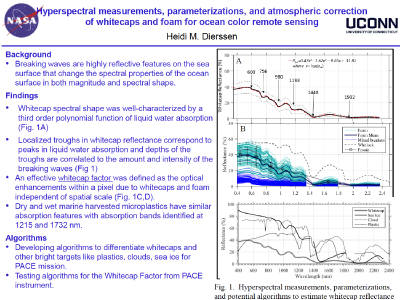
Hyperspectral Measurements, Parameterizations, and Atmospheric Correction of Whitecaps and Foam for Ocean Color Remote Sensing
Dierssen, H. (03-Jun-20) 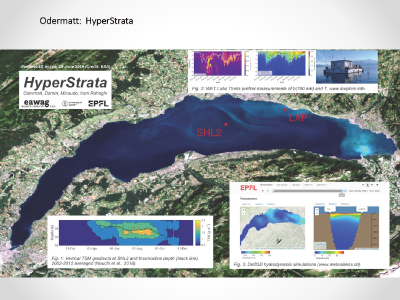
HyperStrata
Odermatt, D., Damm, A., and Minaudo, C. (03-Jun-20) 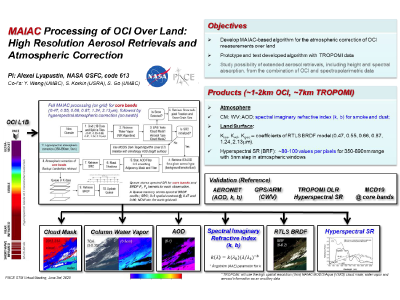
MAIAC Processing of OCI Over Land: High Resolution Aerosol Retrievals and Atmospheric Correction
Lyapustin, A., Go, S., Korkin, S., and Wang, Y. (03-Jun-20) 
Maximizing Utility of PACE in Coastal and Major Freshwater Ecosystems: Advancing Science for Societal Benefits
Pahlevan, N., Binding, C., Boss, E., Kudela, R., Stumpf, R., and Uz, S.S (03-Jun-20) 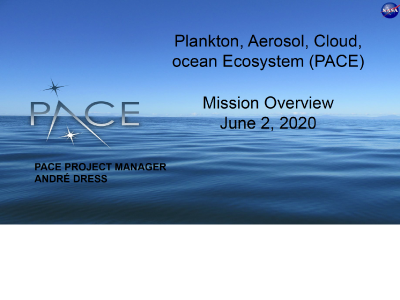
Mission Overview
Dress, A. (02-Jun-20) 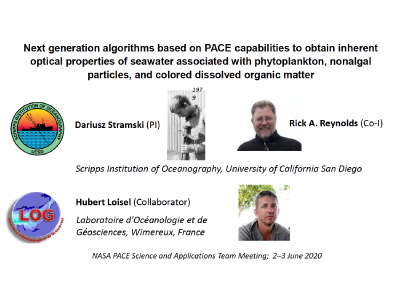
Next Generation Algorithms Based on PACE Capabilities to Obtain Inherent Optical Properties of Seawater Associated with Phytoplankton, Nonalgal Particles, and Colored Dissolved Organic Matter
Stramski, D. and Reynolds, R.A. (03-Jun-20) 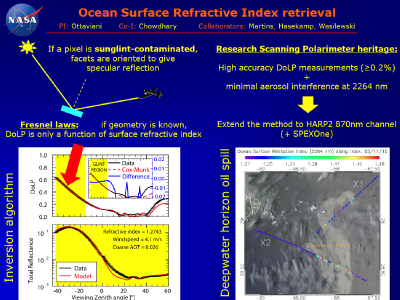
Ocean Surface Refractive Index retrieval
Ottaviani, M. and Chowdhary, J. (03-Jun-20) 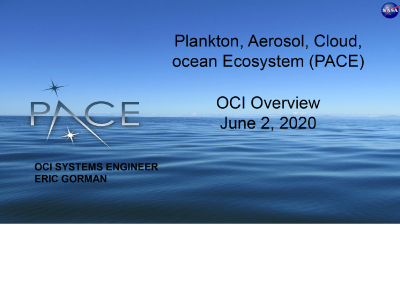
OCI Overview
Gorman, E. (02-Jun-20) 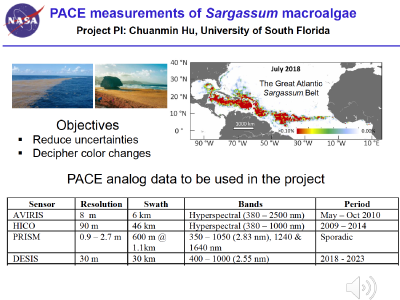
PACE Measurements of Sargassum macroalgae
Hu, C., Goni, G.J., and Lapointe, B. (03-Jun-20) 
PACE UV-ROAD Project
Chowdhary, J., Liu, L., Ottaviani, M., Tsigaridis, K. (03-Jun-20) 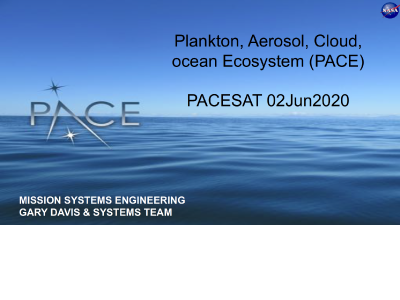
PACESAT
Davis, G. and Systems Team (02-Jun-20) 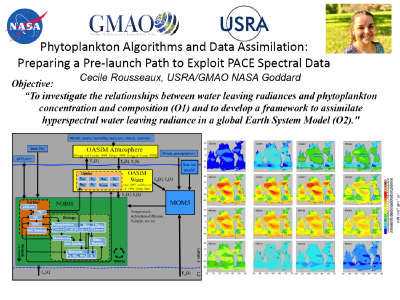
Phytoplankton Algorithms and Data Assimilation: Preparing a Pre-launch Path to Exploit PACE Spectral Data
Rousseaux, C. (03-Jun-20) 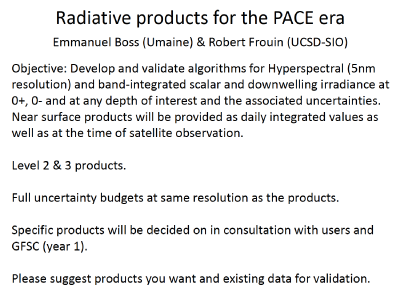
Radiative Products for the PACE Era
Boss, E. and Frouin, R. (03-Jun-20) 
Remote Sensing of Cloud Properties using PACE SPEXone and HARP-2
van Diedenhoven, B., Alexandrov, M., Geogdzhayev, I., Miller, D., and Zhang, Z. (03-Jun-20) 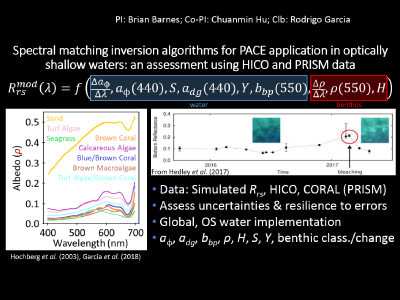
Spectral Matching Inversion Algorithms for PACE Application in Optically Shallow Waters: An Assessment Using HICO and PRISM Data
Barnes, B. and Hu, C. (03-Jun-20) 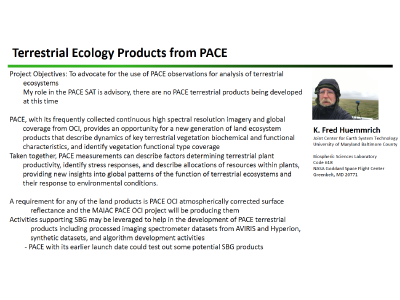
Terrestrial Ecology Products from PACE
Huemmrich, K.F. (03-Jun-20) 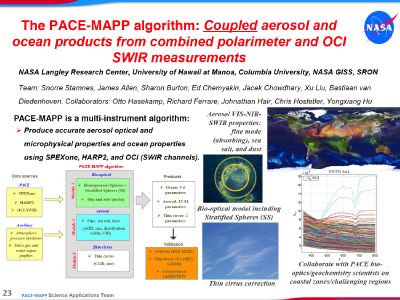
The PACE-MAPP Algorithm: Coupled Aerosol and Ocean Products from Combined Polarimeter and OCI SWIR Measurements
Stamnes, S., Burton, S., Chowdhary, J., Liu, X., and van Diedenhoven, B. (03-Jun-20) 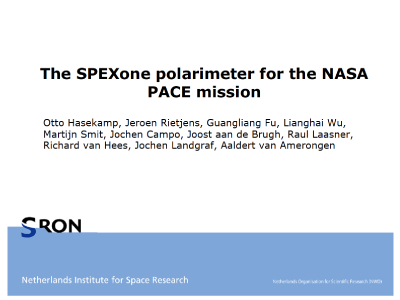
The SPEXone Polarimeter for the NASA
PACE Mission
Hasekamp, O., Rietjens, J., Fu, G., Wu, L., Smit, M., Campo, J., aan de Brugh, J., Laasner, R., van Hees, R., Landgraf, J., and van Ameronge, A. (02-Jun-20) 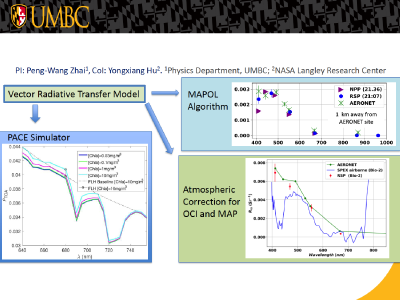
Theoretical Support for Developing the PACE Atmospheric Correction Algorithm: Radiative Transfer and Polarimetric Retrieval of Aerosol Properties
Zhai, P. and Hu, Y. (03-Jun-20) 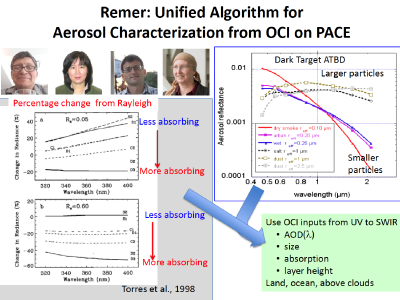
Unified Algorithm for Aerosol Characterization from OCI on PACE
Remer, L., Hsu, N.C., Levy, R.C., and Torres, O. (03-Jun-20) 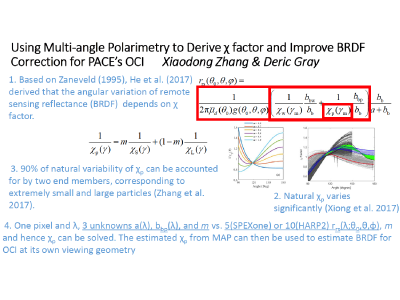
Using Multi-Angle Polarimetry to Derive Χ Factor and Improve BRDF Correction for PACE’s OCI
Zhang, X. and Gray, D. (03-Jun-20) NASA/IOCCG Aquatic Primary Productivity Workshop
December 05-07, 2018Columbia, Maryland USA
Documents (12)
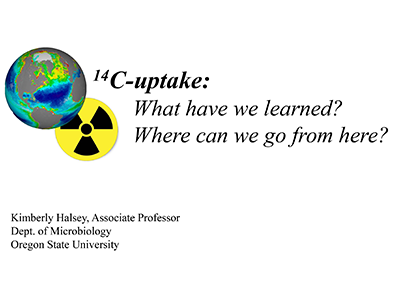
14C Uptake: What Have We Learned? Where Can We Go From Here?
Halsey, K. (05-Dec-18) 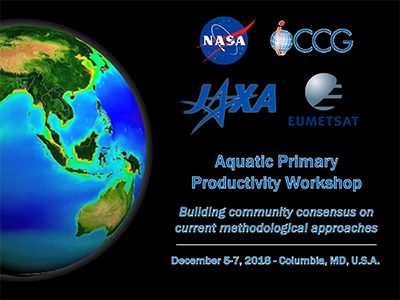
Aquatic Primary Productivity Workshop Introduction
Vandermeulen, R. (05-Dec-18) 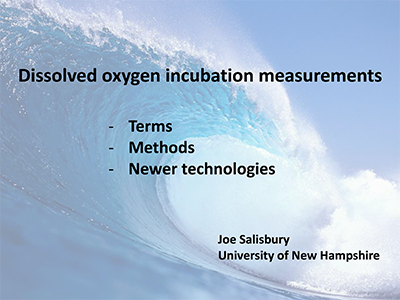
Dissolved Oxygen Incubation: Terms, Methods, Newer Technologies
Salisbury, J. (05-Dec-18) 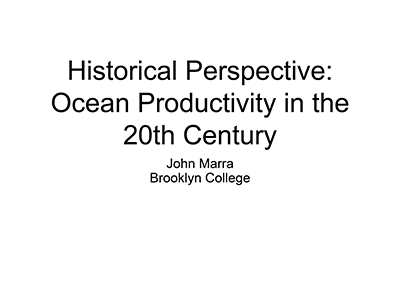
Historical Perspective: Ocean Productivity in the 20th Century
Marra, J. (05-Dec-18) 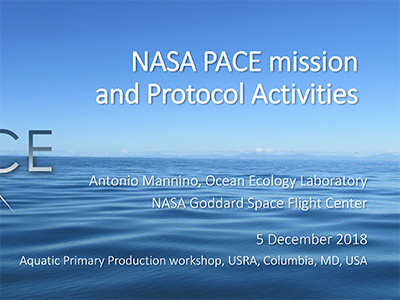
NASA PACE Mission and Protocol Activities
Mannino, A. (05-Dec-18) 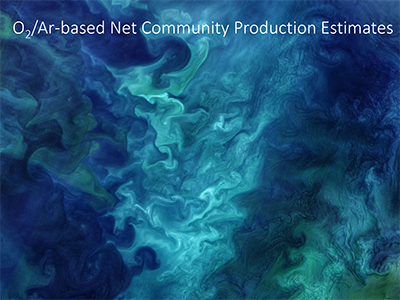
O2/Ar-Based Net Community Production Estimates
Juranek, L. (05-Dec-18) 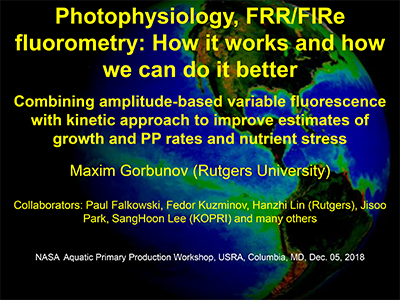
Photophysiology, FRR/FIRe Fluorometry: How it Works and How We Can Do Better
Gorbunov, M., Falkowski, P., Kuzminov, F., Lin, H., Park, J., Lee, S., et al. (05-Dec-18) 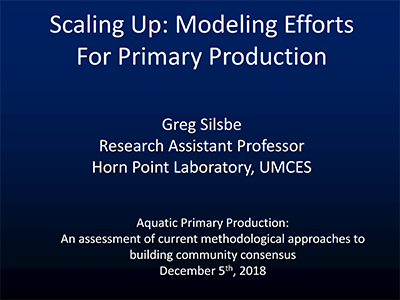
Scaling Up: Modeling Efforts for Primary Production
Silsbe, G. (05-Dec-18) 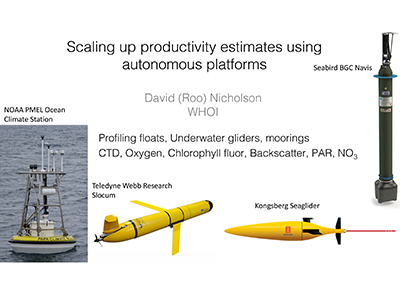
Scaling Up: Productivity Estimates Using Autonomous Platforms
Nicholson, D. (05-Dec-18) 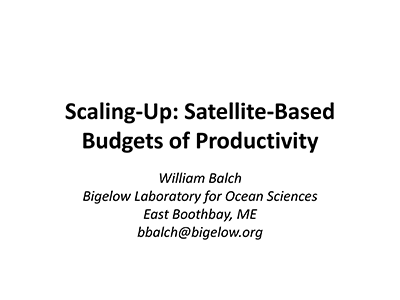
Scaling Up: Satellite-Based Budgets of Productivity
Balch, W. (05-Dec-18) 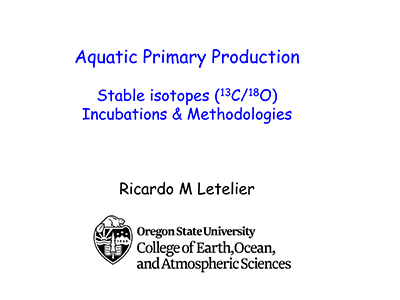
Stable Isotopes (13C/18O) Incubations and Methodology
Letelier, R.M. (05-Dec-18) 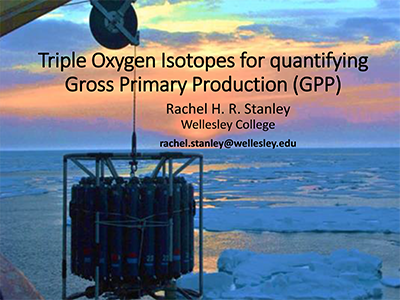
Triple Oxygen Isotopes for Quantifying Gross Primary Production (GPP)
Stanley, R.H.R. (05-Dec-18) 2018 Science Team Meeting
January 16-18, 2018Harbor Branch Oceanographic Institute, Florida USA
Documents (26)
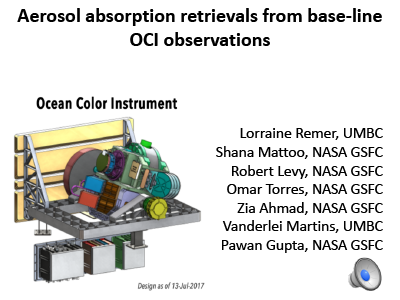
Aerosol Absorption Retrievals from Base-Line OCI Observations
Remer, L., Mattoo, S., Levy, R., Torres, O., Ahmad, Z., Martins, V., and Gupta, P. (16-Jan-18). Click here to view this presentation with audio. 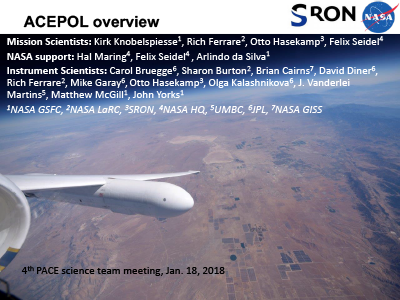
Aerosol Characterization from Polarimeter and Lidar (ACEPOL) Overview
Knobelspiesse, K., Ferrare, R., Hasekamp, O., Maring, H., Seidel, F., da Silva, A., Bruegge, C., Burton, S., Cairns, B., Diner, D., Garay, M., Hasekamp, O., Kalashnikova, O., Vanderlei Martins, J., McGill, M., and Yorks, J. (16-Jan-18). View the animation from slide 10. 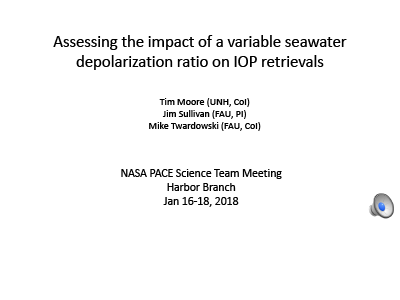
Assessing the Impact of a Variable Seawater Depolarization Ratio on IOP Retrievals
Moore, T., Sullivan, J., and Twardowski, M. (16-Jan-18) 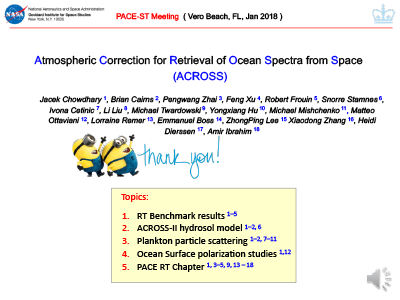
Atmospheric Correction for Retrieval of Ocean Spectra from Space (ACROSS)
Chowdhary, J., Cairns, B., Zhai, P., Xu, F., Frouin, R., Stamnes, S., Cetinić, I., Liu, L., Twardowski, M., Hu, Y., Mischenko, M., Ottaviani, M., Remer, L., Boss, E., Lee, Z., Zhang, X., Dierssen, H., and Ibrahim, A. (16-Jan-18). Topics: 1) RT benchmark results,
2) ACROSS-II hydrosol model,
3) plankton particle scattering,
4) ocean surface polarization studies, and
5) PACE RT chapter.
Click here to view this presentation with audio. 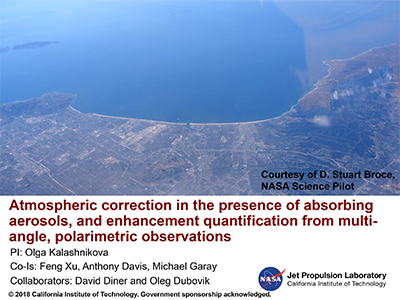
Atmospheric Correction in the Presence of Absorbing Aerosols and Enhancement Quantification from Multi-Angle, Polarimetric Observations
Kalashnikova, O., Xu, F., Davis, A., and Garay, M. (16-Jan-18) 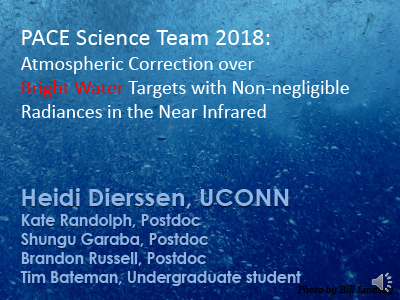
Atmospheric Correction over Bright Water Targets with Non-negligible Radiances in the Near Infrared
Dierssen, H., Randolph, K., Garaba, S., Russell, B., and Bateman, T. (16-Jan-18). Click here to view this presentation with audio. 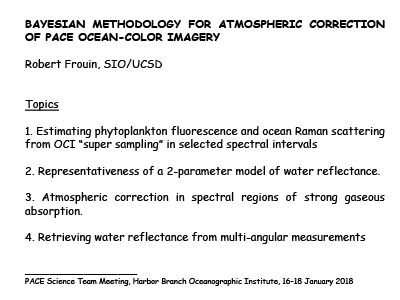
Bayesian Methodology for Atmospheric Correction of PACE Ocean-Color Imagery
Frouin, R. (16-Jan-18) 
Collecting and Processing Underway In-Line Optical Data
Boss, E., Balch, B., Bowler, B., Dall'Olmo, G., Freeman, S., Neary, W., Nelson, N., Novak, M., Proctor, C., Slade, W., Westberry, T., Haentjens, N. and Chase, A. (16-Jan-18). Click here to view this presentation with audio. 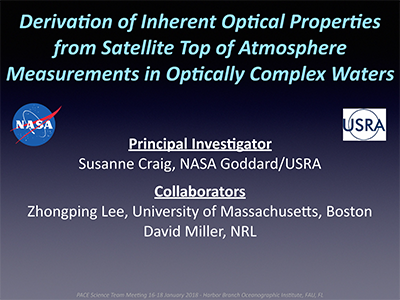
Derivation of Inherent Optical Properties from Satellite Top of Atmosphere Measurements in Optically Complex Waters
Craig, S., Lee, Z., and Miller, D. (16-Jan-18) 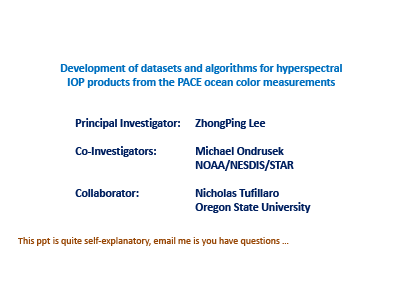
Development of Datasets and Algorithms for Hyperspectral IOP Products from the PACE Ocean Color Measurements
Lee, Z., Ondrusek, M., and Tufillaro, N. (16-Jan-18) 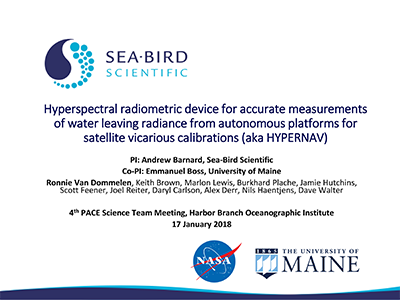
Hyperspectral Radiometric Device for Accurate Measurements of Water Leaving Radiance from Autonomous Platforms for Satellite Vicarious Calibrations (aka HYPERNAV)
Barnard, A., Boss, E., Van Dommelen, R., Brown, K., Lewis, M., Plache, B., Hutchins, J., Feener, S., Reiter, J., Carlson, D., Derr, A., Haentjens, N., and Walter, D. (24-Apr-18) 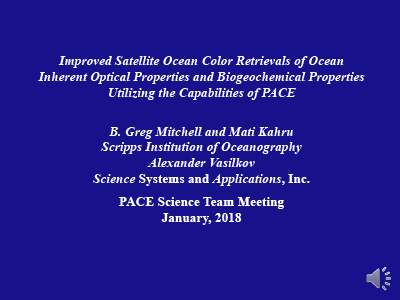
Improved Satellite Ocean Color Retrievals of Ocean Inherent Optical Properties and Biogeochemical Properties Utilizing the Capabilities of PACE
Mitchell, B.G., Kahru, M., and Vasilkov, A. (16-Jan-18). Click here to view this presentation with audio. 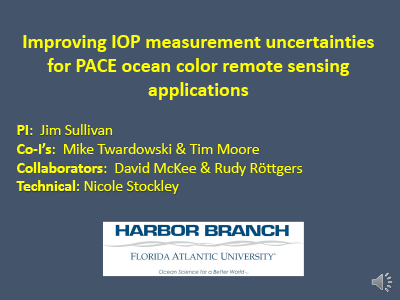
Improving IOP Measurement Uncertainties for PACE Ocean Color Remote Sensing Applications
Sullivan, J., Twardowski, M., Moore, T., McKee, D., Röttgers, R., and Stockley, N. (16-Jan-18). Click here to view this presentation with audio. 
Improving Retrieval of IOPs from Ocean Color Remote Sensing Through Explicit Consideration of the Volume Scattering Function
Twardowski, M. and Tonizzo, A. (16-Jan-18). Click here to view this presentation with audio. 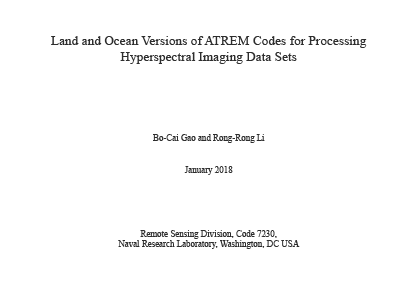
Land and Ocean Versions of ATREM Codes for Processing Hyperspectral Imaging Data Sets
Gao, B-C. and Li, R-R. (16-Jan-18) 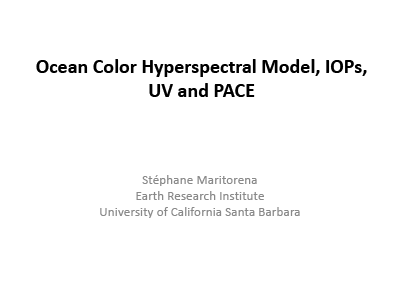
Ocean Color Hyperspectral Model, IOPs, UV and PACE
Maritorena, S. (16-Jan-18). Click here to view this presentation with audio. 
PACE Applications to Case II Waters: Backscatter Response to Particle Composition and Morphology
Ackleson, S. and Moses, W. (16-Jan-18). Click here to view this presentation with audio. 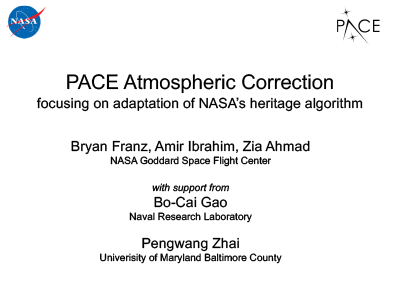
PACE Atmospheric Correction Focusing on Adaptation of NASA’s Heritage Algorithm
Franz, B., Ibrahim, A., Ahmad, Z., Gao, B-C., and Zhai, P. (16-Jan-18) 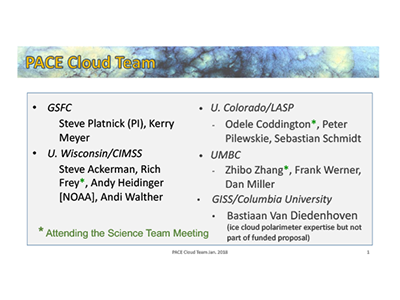
PACE Cloud Team
Platnick, S., Meyer, K., Ackerman, S., Frey, R., Heidinger, A., Walther, A., Coddington, O., Pilewskie, P., Schmidt, S., Zhang, Z., Werner, F., Miller, D., and Van Diedenhoven, B. (16-Jan-18) 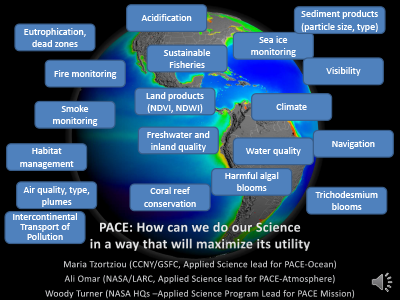
PACE: How Can We Do Our Science in a Way That Will Maximize its Utility
Tzortziou, M., Omar, A., and Turner, W. (16-Jan-18). Click here to view this presentation with audio. 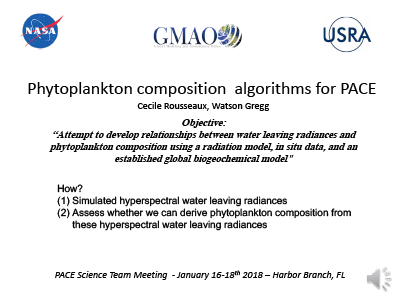
Phytoplankton Composition Algorithms for PACE
Rousseaux, C. and Gregg, W. (16-Jan-18). Click here to view this presentation with audio. 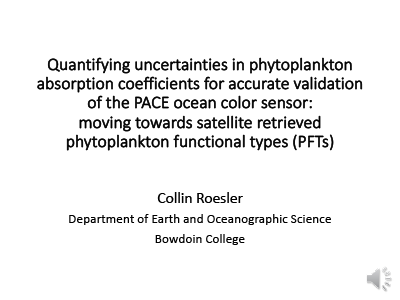
Quantified Uncertainties in Phytoplankton Absorption Coeifficients for Accurate Validation of the PACE Ocean Color Sensor: Moving Towards Retrieved Phytoplankton Functional Types (PFTs)
Roesler, C. (16-Jan-18). Click here to view this presentation with audio. 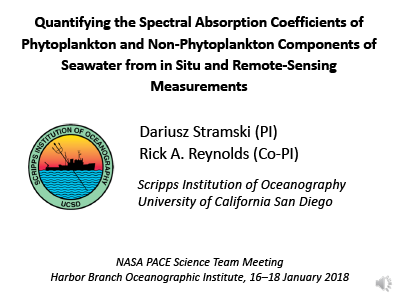
Quantifying the Spectral Absorption Coefficients of Phytoplankton and Non-Phytoplankton Components of Seawater from in Situ and Remote-Sensing Measurements
Stramski, D. and Reynolds, R.A. (16-Jan-18). Click here to view this presentation with audio. 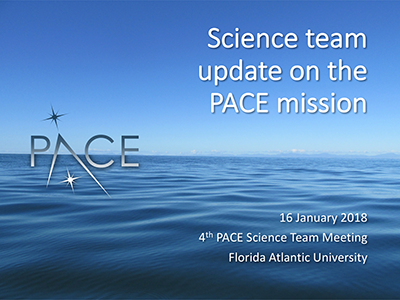
Science Team Update on the PACE Mission
Werdell, J. (16-Jan-18) 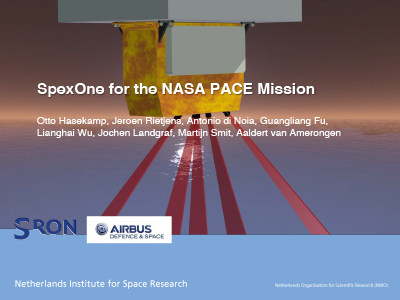
SpexOne for the NASA PACE Mission
Hasekamp, O., Rietjens, J., di Noia, A., Fu, G., Wu, L., Landgraf, J., Smit, M., and van Amerongen, A. (16-Jan-18) 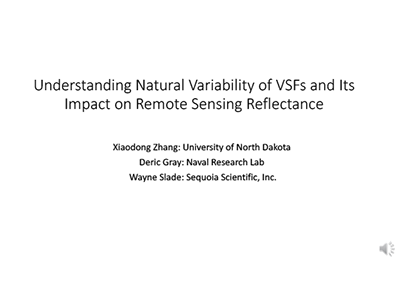
Understanding Natural Variability of VSFs and Its Impact on Remote Sensing Reflectance
Zhang, X., Gray, D., and Slade, W. (16-Jan-18). Click here to view this presentation with audio. 2017 Science Team Meeting
January 17-19, 2017Harbor Branch Oceanographic Institute, Florida USA
Documents (27)
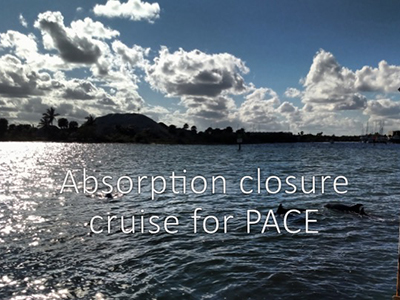
Absorption Closure Cruise for PACE
Twardowski, M. (17-Jan-17) 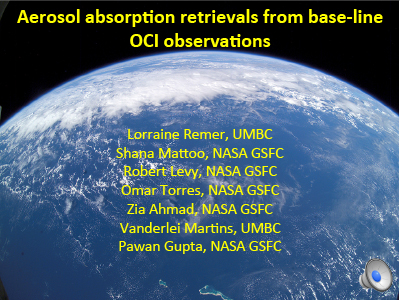
Aerosol Absorption Retrievals from Base-line OCI Observations
Remer, L., Mattoo, S., Levy, R., Torres, O., Ahmad, Z., Vanderlei, M., and Gupta, P. (17-Jan-17). Click here to view this presentation with audio. 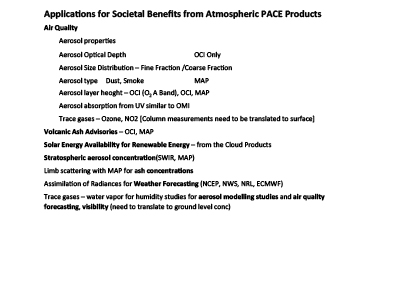
Applications for Societal Benefits from Atmospheric PACE Products
Omar, A. (17-Jan-17) 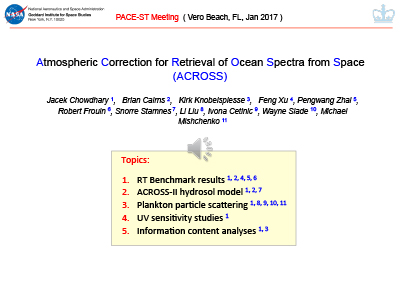
Atmospheric Correction for Retrieval of Ocean Spectra from Space (ACROSS)
Chowdhary, J., Cairns, B., Knobelspiesse, K., Xu, F., Zhai, P., Frouin, R., Stamnes, S., Liu, L., Cetinić, I., Slade, W., and Mishchenko, M. (17-Jan-17). Topics: 1) RT benchmark results, 2) ACROSS-II hydrosol model, 3) plankton particle scattering 4) UV sensitivity studies, and
5) information content analyses.
Click here to view this presentation with audio. 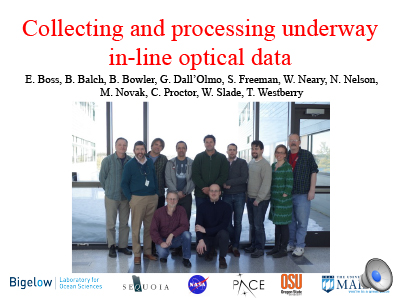
Collecting and Processing Underway In-line Optical Data
Boss, E., Balch, B., Bowler, B., Dall'Olmo, G., Freeman, S., Neary, W., Nelson, N., Novak, M., Proctor, C., Slade, W., and Westberry, T. (17-Jan-17). Click here to view this presentation with audio. 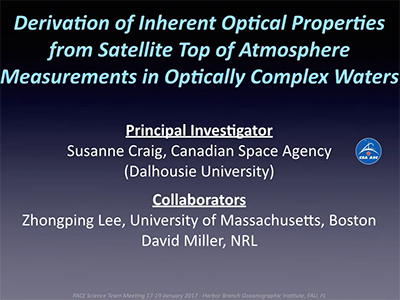
Derivation of Inherent Optical Properties from Satellite Top of Atmosphere Measurements in Optically Complex Waters
Craig, S., Lee, W., and Miller, D. (17-Jan-17). Click here to view this presentation with audio. 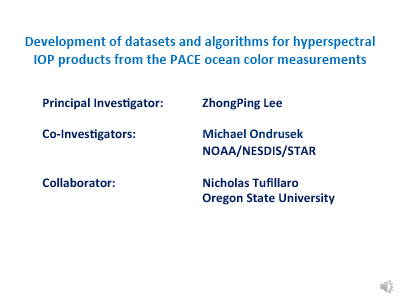
Development of Datasets and Algorithms for Hyperspectral IOP Products from the PACE Ocean Color Measurements
Lee, Z., Ondrusek, M., and Tufillaro, N. (17-Jan-17). Click here to view this presentation with audio. 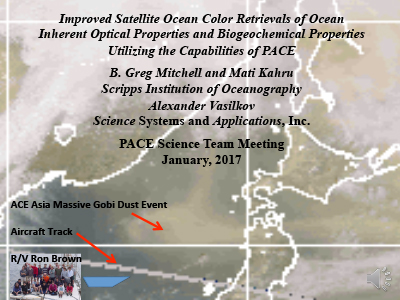
Improved Satellite Ocean Color Retrievals of Ocean Inherent Optical Properties and Biogeochemical Properties Utilizing the Capabilities of PACE
Mitchell, B.G., Kahru, M., and Vasilkov, A. (17-Jan-17) 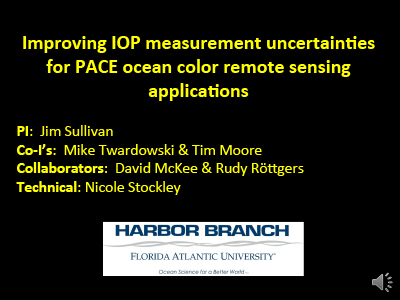
Improving IOP Measurement Uncertainties for PACE Ocean Color Remote Sensing Applications
Sullivan, J., Twardowski, M., Moore, T., McKee, D., Röttgers, R., and Stockley, N. (17-Jan-17). Click here to view this presentation with audio. 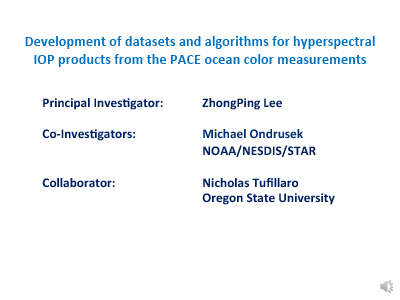
Improving Retrieval of IOPs from Ocean Color Remote Sensing Through Explicit Consideration of the Volume Scattering Function
Twardowski, M., Sullivan, J., Tonizzo, A., Stockley, N., Freeman, S., and Slivkoff, M. (17-Jan-17). Click here to view this presentation with audio. 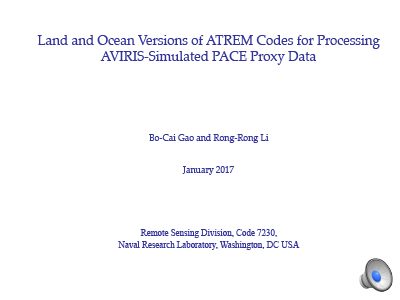
Land and Ocean Versions of ATREM Codes for Processing AVIRIS-Simulated PACE Proxy Data
Gao, B-C. and Li, R-R. (17-Jan-17). Click here to view this presentation with audio. 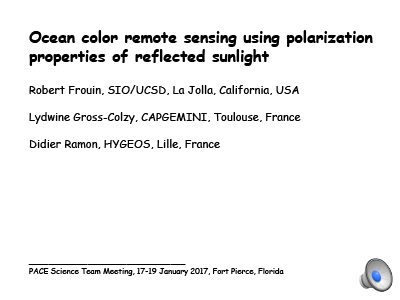
Ocean Color Remote Sensing Using Polarization Properties of Reflected Sunlight
Frouin, R., Gross-Colzy, L., and Ramon, D. (17-Jan-17). Click here to view this presentation with audio. 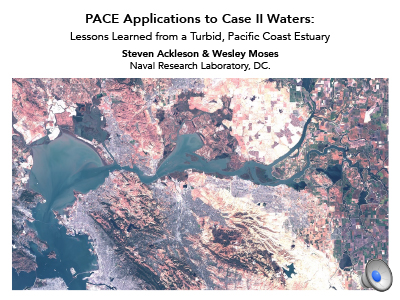
PACE Applications to Case II Waters: Lessons Learned from a Turbid, Pacific Coast Estuary
Ackleson, S. and Moses, W. (17-Jan-17). Click here to view this presentation with audio. 
PACE Atmospheric Correction Focusing on Adaptation of NASA’s Heritage Algorithm
Franz, B., Ibrahim, A., Ahmad, Z., Healy, R., and Gao, B-C. (17-Jan-17) 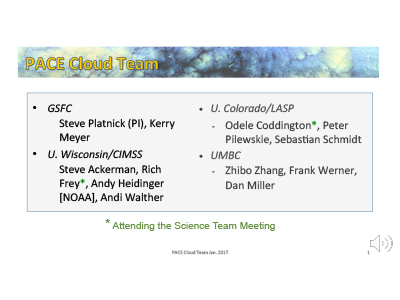
PACE Cloud Team Proposal
Platnick, S., Meyer, K., Ackerman, S., Frey, R, Heidinger, A, Walther, A., Coddington, O., Pilewskie, P., Schmidt, S., Zhang, Z., Werner, F., and Miller, D. (17-Jan-17). Click here to view this presentation with audio. 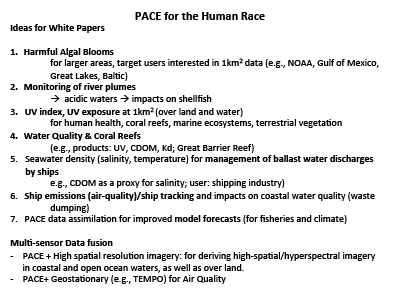
PACE for the Human Race : Ideas for White Papers
Tzortziou, M. (17-Jan-17) 
PACE Science Team: Atmospheric Correction over Bright Water Targets with Non-negligible Radiances in the Near Infrared
Dierssen, H., Randolph, K., Garaba, S., Zhai, P., and Gao, B-C. (17-Jan-17) 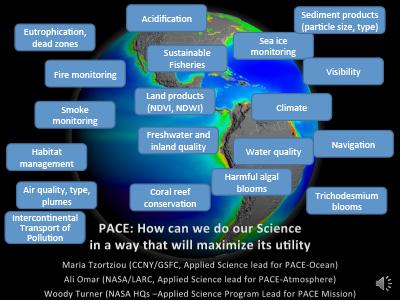
PACE: How Can We Do Our Science in a Way that Will Maximize its Utility
Tzortziou, M., Omar, A., and Turner, W. (17-Jan-17). Click here to view this presentation with audio. 
Phytoplankton Composition Algorithms for PACE
Rousseaux, C. and Gregg, W. (17-Jan-17). Click here to view this presentation with audio. 
Quantifying the Spectral Absorption Coefficients of Phytoplankton and Non-Phytoplankton Components of Seawater from in Situ and Remote-Sensing Measurements
Stramski, D. and Reynolds, R.A. (17-Jan-17). Click here to view this presentation with audio. 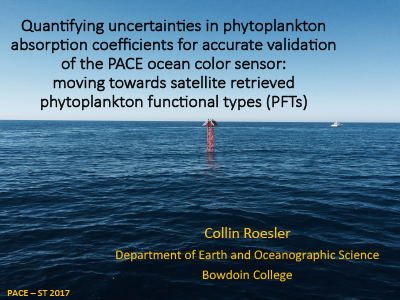
Quantifying Uncertainties in Phytoplankton Absorption Coefficients for Accurate Validation of the PACE Ocean Color Sensor: Moving Towards Satellite Retrieved Phytoplankton Functional Types (PFTs)
Roesler, C. (17-Jan-17) 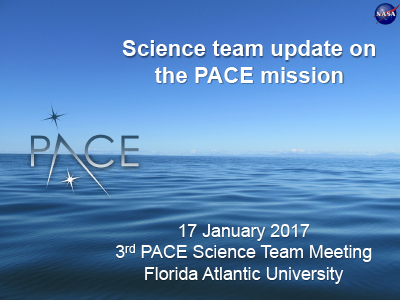
Science Team Update on the PACE Mission
Werdell, J. (17-Jan-17) 
Subgroup Report: Database Status
Rousseaux, C. and Casey, K. (17-Jan-17) 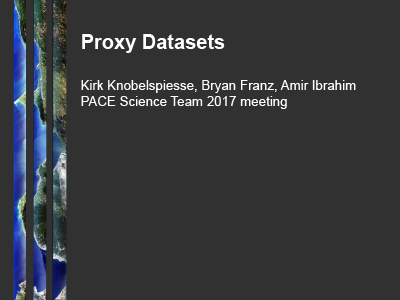
Subgroup Report: Proxy Datasets
Knobelspiesse, K., Franz, B., and Ibrahim, A. (17-Jan-17) 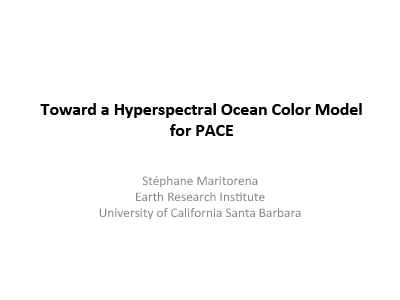
Toward a Hyperspectral Ocean Color Model for PACE
Maritorena, S. (17-Jan-17) 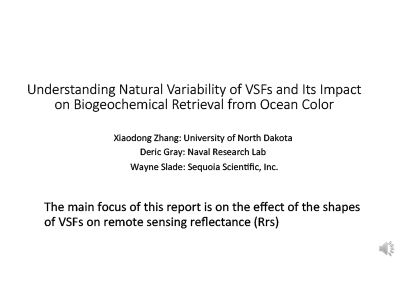
Understanding Natural Variability of VSFs and its Impact on Biogeochemical Retrieval from Ocean Color
Zhang, X., Gray, D., and Slade, W. (17-Jan-17). Click here to view this presentation with audio. 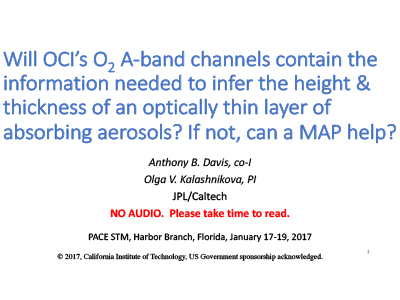
Will OCI’s O2 A-band Channels Contain the Information Needed to Infer the Height & Thickness of an Optically Thin Layer of Absorbing Aerosols? If Not, Can a MAP Help?
Davis, A.B. and Kalashnikova, O.V. (17-Jan-17) 2016 NASA Ocean Color Research Team Meeting
May 2-4, 2016Silver Spring, Maryland USA
Documents (3)
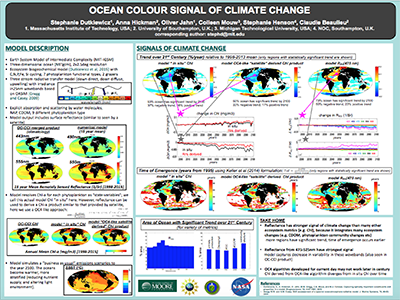
Ocean Colour Signal of Climate Change
Dutkiewicz, S., Hickman, A., Jahn, O., Mouw, C., Henson, S., and Beaulieu, C. (04-May-16) 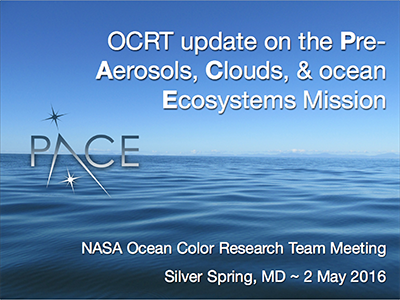
OCRT update on the Pre-Aerosols, Clouds and ocean Ecosystems Mission
Werdell, J. (04-May-16) 
Remote Sensing of Atmosphere-Ocean Systems in the UV: How Can Polarimetry Help Distinguish Reflectance Variations Caused by Absorbing Aerosols from Variations Caused by CDOM?
Chowdhary, J. and Cairns, B. (04-May-16) 2016 Ocean Sciences Meeting
February 21-26, 2016New Orleans, Louisiana USA
Documents (16)
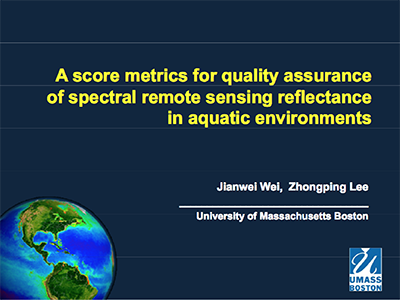
A Novel Scoring Metrics for Quality Assurance of Ocean Color Observations
Wei, J. (26-Feb-16). Interpretation of the ocean bio-optical properties from ocean color observations depends on the quality of the ocean color data, specifically the spectrum of remote sensing reflectance (Rrs). The in situ and remotely measured Rrs spectra are inevitably subject to errors induced by instrument calibration, sea-surface correction and atmospheric correction, and other environmental factors. Great efforts have been devoted to the ocean color calibration and validation. Yet, there exist no objective and consensus criteria for assessment of the ocean color data quality. In this study, the gap is filled by developing a novel metrics for such data quality assurance and quality control (QA/QC). 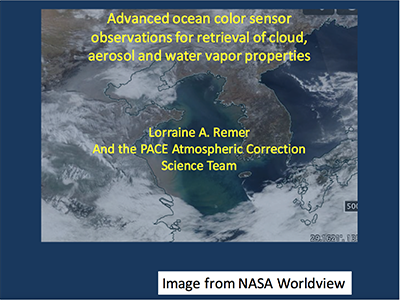
Advanced Ocean Color Sensor Observations for Retrieval of Cloud, Aerosol and Water Vapor Properties
Remer, L.A. (26-Feb-16). While the next generation of ocean color sensors offers enhanced capability to retrieve ocean parameters and to advance ocean science, these sensors also offer enhanced capability for observing atmospheric parameters, as well. In particular advanced ocean color sensors are expected to broaden the spectral range to include bands from the UV to the SWIR, inclusive on a single instrument that will observe aquatic, terrestrial and atmospheric targets with the same geometry, same spatial resolution, and similar calibration strategies across the entire spectrum. 
Advancing Ocean Remote Sensing with Spaceborne Lidar
Hostetler, C.A., Behrenfeld, M.J., Hair, J.W., Hu, Y., Powell, K.A., Scarino, A.J., Butler, C.F., Boss, E., Siegel, D., and Cetinić, I. (26-Feb-16). Global estimates of phytoplankton biomass (Cphyto) and particulate organic carbon (POC) have traditionally been made using passive ocean color measurements. Recently, data from the CALIOP sensor on the CALIPSO satellite have provided the first measurements of these two key carbon cycle stocks from a space-based lidar despite the fact that CALIOP was not designed for subsurface ocean retrievals. 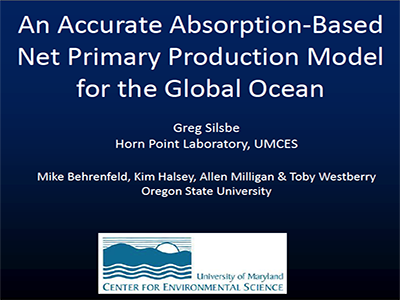
An Accurate Absorption-Based Net Primary Production Model for the Global Ocean
Silsbe, G., Westberry, T.K., Behrenfeld, M.J., Halsey, K., and Milligan, A. (26-Feb-16). As a vital living link in the global carbon cycle, understanding how net primary production (NPP) varies through space, time, and across climatic oscillations (e.g. ENSO) is a key objective in oceanographic research. The continual improvement of ocean observing satellites and data analytics now present greater opportunities for advanced understanding and characterization of the factors regulating NPP. 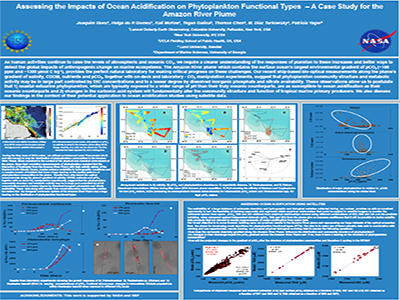
Assessing the Impacts of Ocean Acidification on Phytoplankton Functional Types from Space - A Case Study for the Amazon River Plume (Poster)
Goes, J.I., Gomes, H.R., McKee, K., Galina, T., Chen, T.L., Turkowsky, M.D., and Yager, P.L. (26-Feb-16). As human activities continue to raise the levels of atmospheric and oceanic CO2, we require a clearer understanding of the responses of plankton to these increases and better ways to detect the global impacts of anthropogenic change on marine ecosystems. 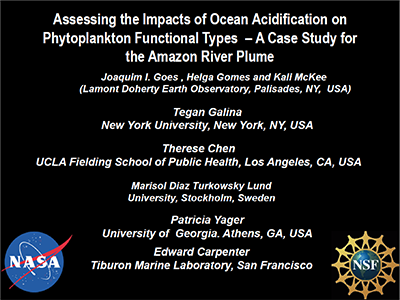
Assessing the Impacts of Ocean Acidification on Phytoplankton Functional Types from Space - A Case Study for the Amazon River Plume (Presentation)
Goes, J.I., Gomes, H.R., McKee, K., Galina, T., Chen, T.L., Turkowsky, M.D., and Yager, P.L. (26-Feb-16). As human activities continue to raise the levels of atmospheric and oceanic CO2, we require a clearer understanding of the responses of plankton to these increases and better ways to detect the global impacts of anthropogenic change on marine ecosystems. 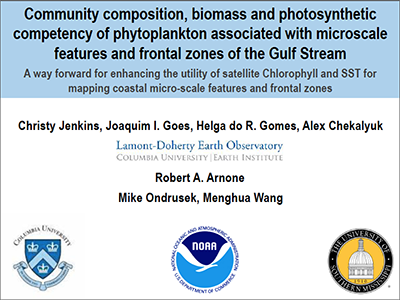
Community Composition, Biomass and Photosynthetic Competency of Phytoplankton Associated with Microscale Features and Frontal Zones of the Gulf Stream
Jenkins, C.A., Goes, J.I., Gomes, H.R., Chekalyuk, A.M., Arnone, R., and Tufillaro, N.B. (26-Feb-16). Frontal zones and microscale oceanographic features are easily observable from satellite measurements of SST and Chl a. Enhancing the utility of these space borne measurements for biological productivity, biogeochemical cycling and fisheries studies, will require novel bio-optical methods capable of providing information on the community structure, biomass and photo-physiology of phytoplankton, especially in regions where these smaller but prominent oceanographic features exist. 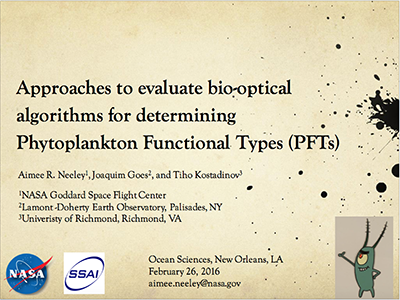
Evaluation of Bio-optical Models for Discriminating Phytoplankton Functional Types and Size Classes in Eastern U.S. Coastal Waters with Approaches to Remote Sensing Applications
Neeley, A.R., Goes, J.I., Jenkins, C.A., and Harris, L. (26-Feb-16). Phytoplankton species can be separated into phytoplankton functional types (PFTs) or size classes (PSCs; Micro-, Nano-, and Picoplankton). Bio-optical models have been developed to use satellite-derived products to discriminate PSCs and PFTs, a recommended field measurement for the future NASA PACE mission. 
Improving Methods for Assessing Reflectance Due to Whitecaps and Foam from Ocean Color Imagery
Dierssen, H.M., Randolph, K.L., Garaba, S.P. (26-Feb-16). The standard ocean color atmospheric correction algorithms have a simplistic method for treating whitecaps and foam that relies upon wind speed. However, large variability exists in the relationship between wind speed and whitecap coverage, as well as the amount of reflectance associated with whitecap and foam features. Here, field measurements of the Lambertian Equivalent Reflectance (LER) of whitecaps and foam made from the visible into the short wave infrared (350-2500 nm) are presented. 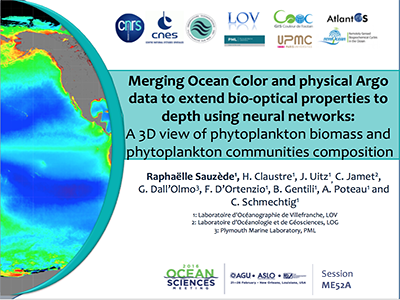
Merging Ocean Color and Physical Argo Data to Extend Bio-optical Properties to Depth Using Neural Networks: A Global 3D View of Phytoplankton Biomass and Phytoplankton Communities Composition
Sauzede, R., Claustre, H., Jamet, C., Uitz, J., Dall'Olmo, G., D'Ortenzio, F., Gentili, B., Poteau, A., and Schmechtig, C. (26-Feb-16). Ocean color observations enable the estimation of bio-optical proxies of phytoplankton biomass (e.g. chlorophyll a concentration, Chla, and particulate backscattering coefficient, bbp) in the surface layer of the ocean quasi-synoptically. In parallel, the Argo program distributes vertical profiles of the ocean physical properties with a global coverage and a high spatio-temporal resolution (every 10 days for ~3°x3° area). 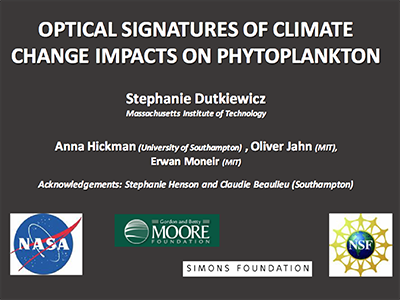
Optical Signatures of Climate Change Impacts on Phytoplankton
Dutkiewicz, S., Hickman, A.E., Jahn, O., and Moneir, E. (26-Feb-16). The ocean marine ecosystems will alter as a consequence of climate change, with ecological and biogeochemical ramifications. Here we use an earth system model which includes marine biogeochemistry and ecosystem, as well as important optical constituents such as coloured dissolved organic matter (CDOM), non-algal particles (NAP) as well as an optically diverse set of phytoplankton types. Importantly, the light field is spectrally resolved and the model outputs surface reflectance similar to that measured by ocean colour satellites. We study the trends over the 21st century in ecologically and biogeochemically important metrics such as primary production and plankton community structure, and in particular how these can be captured by reflectance and other optical characteristics. 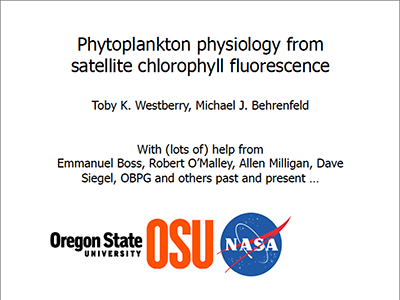
Phytoplankton Physiology from Satellite Chlorophyll Fluorescence
Westberry, T.K. and Behrenfeld, M.J. (26-Feb-16). Fluorescence from the chlorophyll pigment is the only unambiguous signal measured from satellite that can be exclusively attributed to phytoplankton. However, developing a comprehensive understanding of factors regulating satellite-derived fluorescence has been difficult. 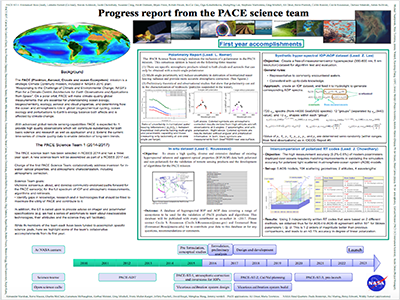
Progress Report From PACE’s Science Team
Boss, E. and Remer, L.A. (26-Feb-16). PACE, NASA's upcoming strategic climate continuity mission is due to launch in 2022. PACE will have a hyperspectral radiometer spanning from 350 to 800nm, several SWIR bands, and a polarimeter, allowing it to be used for studies of ocean biogeochemistry as well as to study clouds and aerosols distribution and microphysics. In anticipation to the launch, a Science Team was competed for and assembled who is tasked with working on algorithms to retrieve inherent optical properties and on atmospheric correction. 
Uncertainties in the Water-leaving Spectral Radiance Derived from Extrapolation of Near-surface Underwater Measurements
Li, L., Stramski, D., and Reynolds, R.A. (26-Feb-16). Extrapolation of near-surface underwater measurements is the most common method to estimate the water-leaving spectral radiance, Lw(λ) (where λ is the light wavelength in vacuum), and remote-sensing reflectance, Rrs(λ), for validation and vicarious calibration of satellite sensors, as well as for ocean color algorithm development. However, uncertainties in Lw(λ) arising from the extrapolation process have not been investigated in detail with regards to the potential influence of inelastic radiative processes such as Raman scattering and fluorescence. 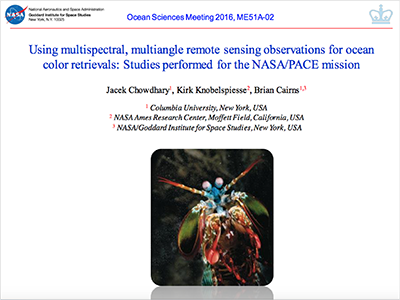
Using Multispectral, Multiangle Polarimetric Remote Sensing Observation for Ocean Color Retrievals: Studies Performed for the Pre-Aerosol, Clouds, and ocean Ecosystem (PACE) Mission
Chowdhary, J., Knobelspiesse, K.D., and Cairns, B. (26-Feb-16). The high sensitivity of polarized light scattered by suspended particles to the properties of these particles has successfully been exploited during the last 40+ years to obtain unique information of aerosols in planetary atmospheres from polarimetry. In addition, promising results have been obtained regarding the sensitivity of polarimetric observations to the properties of marine particulates. This has led to the consideration of adding a polarimeter to the PACE mission. Here, we discuss 3 types of polarization studies performed for this mission. 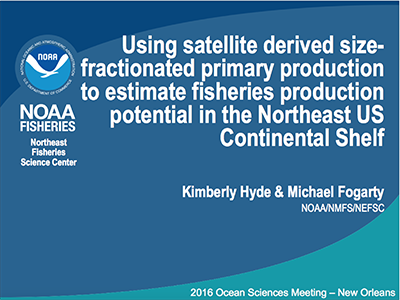
Using Satellite Derived Size-fractionated Primary Production Estimates to Estimate Fisheries Production Potential in the Northeast US Continental Shelf
Hyde, K. and Fogarty, M.J. (26-Feb-16). Advances in satellite derived phytoplankton size class and functional type models have broadened the fisheries application possibilities of ocean color remote sensing. Here we partition phytoplankton biomass and primary production into microplankton and nano-picoplankton size classes for use in a bottom-up approach to estimate fisheries production and exploitation rate potentials. 2016 Science Team Meeting
January 20-21, 2016Pasadena, California USA
Documents (29)

A Global Database of High Horizontal Resolution IOPs for Validation of Remotely Sensed Ocean Color
Boss, E. (21-Jan-16) 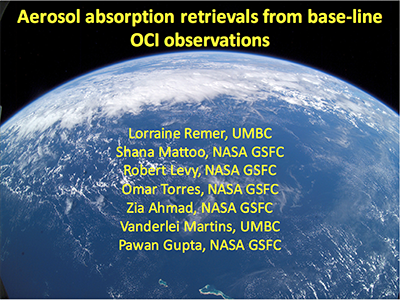
Aerosol Absorption Retrievals from Base-Line OCI Observations: Risk Reduction for Atmospheric Correction of the PACE Mission
Remer, L., Mattoo, S., Levy, R., Torres, O., Ahmad, Z., Martins, V., and Gupta, P. (21-Jan-16) 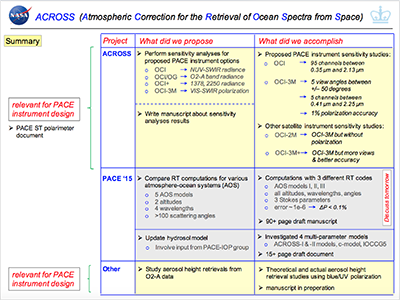
Atmospheric Correction for Retrieval of Ocean Spectra from Space (ACROSS)
Chowdhary, J. (20-Jan-16) 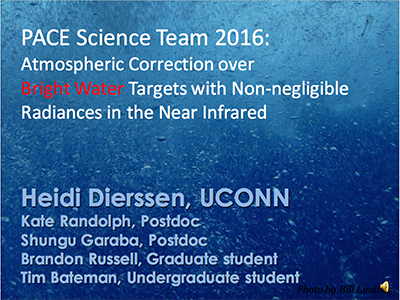
Atmospheric Correction Over Bright Water Targets with Non-Negligible Radiances in the Near Infrared
Dierssen, H., Randolph, K., Garaba, S., Russell, B., and Bateman, T. (20-Jan-16) 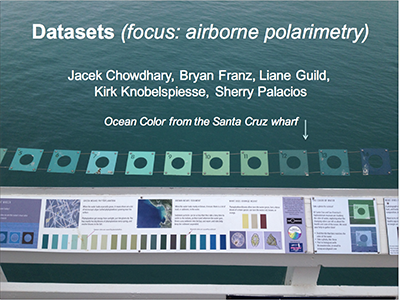
Available Datasets with Polarimeter Data
Chowdhary, J., Franz, B., Guild, L., Knobelspiesse, K., and Palacios, S. (21-Jan-16) 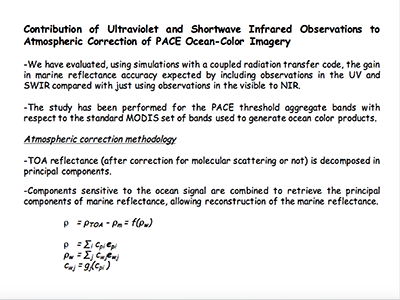
Bayesian Methodology for Atmospheric Correction of PACE Ocean-Color Imager
Frouin, R. (20-Jan-16) 
Benchmark Polarized Modeling
Chowdhary, J. (21-Jan-16) 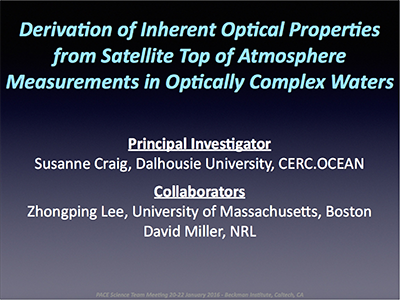
Derivation of Inherent Optical Properties from Satellite Top of Atmosphere Measurements in Optically Complex Waters
Craig, S. and Lee, Z. (21-Jan-16) 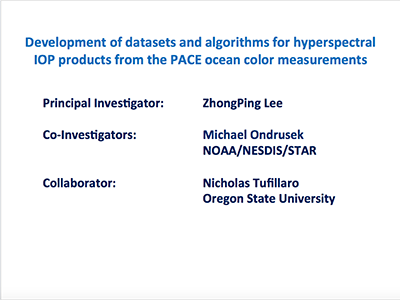
Development of Datasets and Algorithms for Hyperspectral IOP Products from the PACE Ocean Color Measurements
Lee, Z., Onderusek, M., and Tufillaro, N. (20-Jan-16) 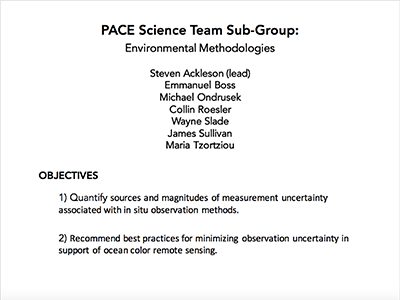
Environmental Methodology
Ackleson, S. (21-Jan-16) 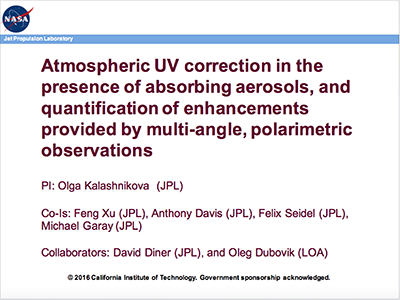
Evaluation of UV Atmospheric Correction in the Presence of Absorbing Aerosols, and Quantification of Enhancements Provided by Multiangle, Polarimetric and Oxygen A-Band Observations
Kalashnikova, O. (20-Jan-16) 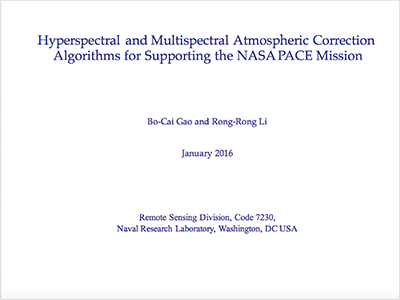
Hyperspectral and Multispectral Atmospheric Correction Algorithms for Supporting the NASA PACE Mission
Gao, B-C. and Li, R-R. (21-Jan-16) 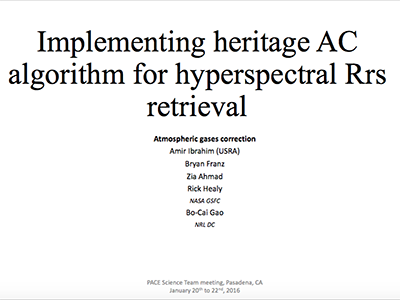
Implementing Heritage AC Algorighm for Hyperspectral Rrs Retrieval
Ibraham, A., Franz, B., Ahmad, Z., Healy, R., and Gao, B-C. (21-Jan-16) 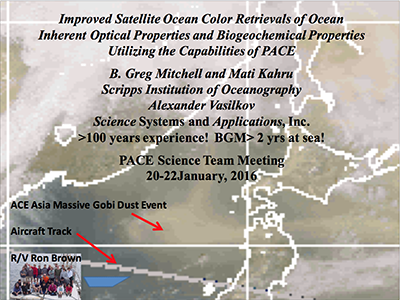
Improved Satellite Ocean Color Retrievals of Ocean Inherent Optical Properties and Biogeochemical Properties Utilizing the Capabilities of PACE
Mitchell, G. and Kahru, M. (21-Jan-16) 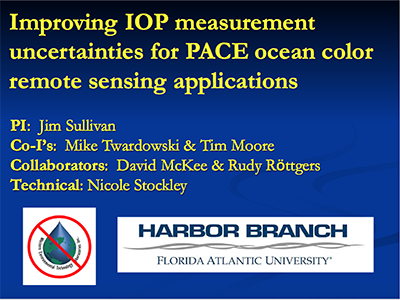
Improving IOP Measurement Uncertainties for PACE Ocean Color Remote Sensing Applications
Sullivan, J. (21-Jan-16) 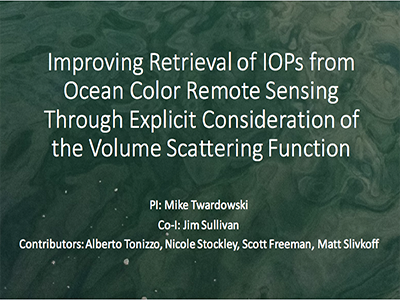
Improving Retrieval of IOPs from Ocean Color Remote Sensing Through Explicit Consideration of the Volume Scattering Function
Twardowski, M., Sullivan, J., Tonizzo, A., Stockley, N., Freeman, S., and Slivkoff, M. (21-Jan-16) 
Inversions for Rrs to IOP: State-of-the-Art
McKinna, L. and Werdell, J. (21-Jan-16) 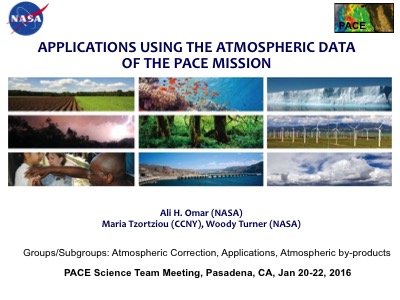
Maximizing the Societal Benefits of PACE Atmospheric Data by Actively Linking the Mission to its Applications
Omar, A. (20-Jan-16) 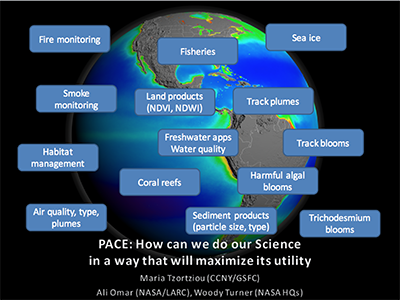
Maximizing the Societal Benefits of PACE IOP Data by Actively Linking the Mission to its Applications
Tzortziou, M., Omar, A., and Turner, W. (20-Jan-16) 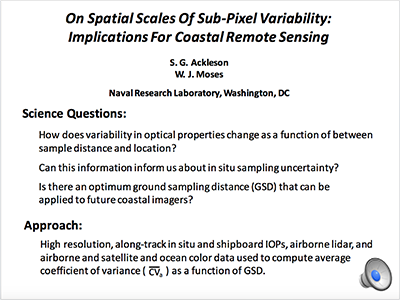
PACE Applications to Case II Waters: Quantifying the Uncertainty in Inherent Optical and Water Constituent Properties and the Impact On Remotely Sensed Ocean Color
Ackleson, S. (20-Jan-16) 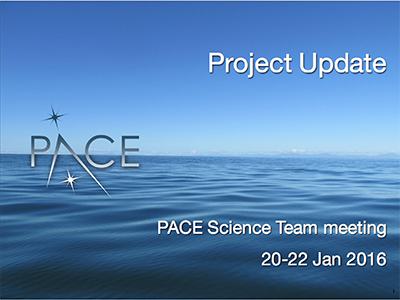
PACE Project Update
Werdell, J. (20-Jan-16) 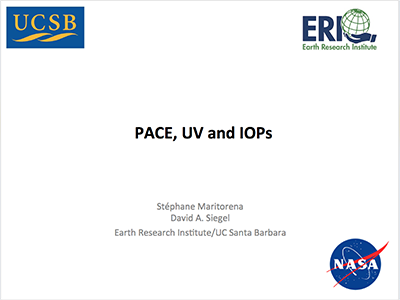
PACE, UV and IOPs
Maritorena, S. and Siegel, D.A. (20-Jan-16) 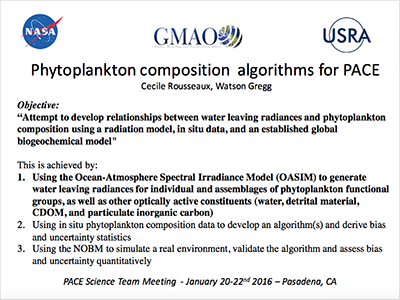
Phytoplankton Composition Algorithms for PACE
Rousseaux, C. and Gregg, W. (20-Jan-16) 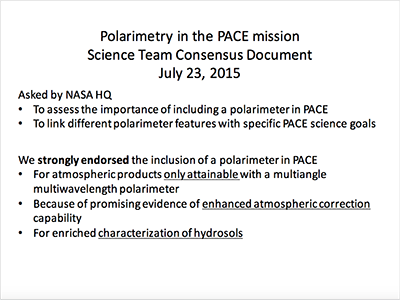
Polarimeter Report and its Conclusion - Polarimetry or Multi-angle Studies, in Progress
Remer, L. (20-Jan-16) 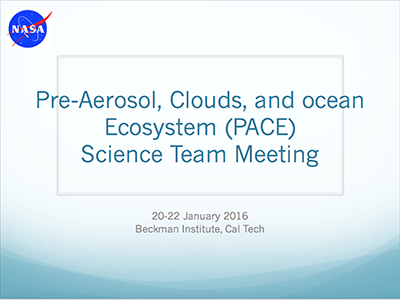
Pre-Aerosol, Clouds and ocean Ecosystem (PACE) Science Team Meeting
Bontempi, P. (20-Jan-16) 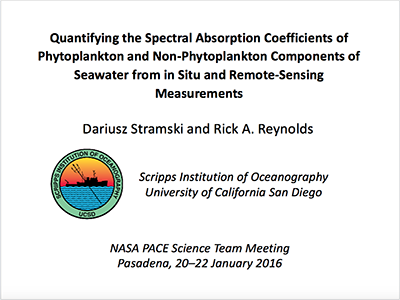
Quantifying the Spectral Absorption Coefficients of Phytoplankton and Non-Phytoplankton Components of Seawater from in Situ and Remote-Sensing Measurements
Stramski, D. and Reynolds, R.A. (21-Jan-16) 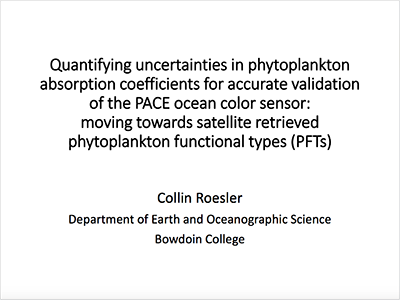
Quantifying Uncertainties in Phytoplankton Absorption Coefficients for Accurate Validation of the PACE Ocean Color Sensor: Moving Towards Satellite Retrieved Phytoplankton Functional Types (PFTs)
Roesler, C. (21-Jan-16) 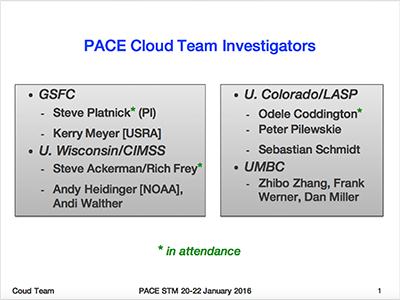
Retrieval Studies in Support of Cloud Property Products from the PACE Ocean Color Imager
Platnick, S. (20-Jan-16) 
Understanding Natural Variability of VSFs and Its Impact on Biogeochemical Retrieval from Ocean Color
Zhang, X. (20-Jan-16) 2015 Science Team Meeting
January 14-16, 2015College Park, Maryland USA
Documents (28)
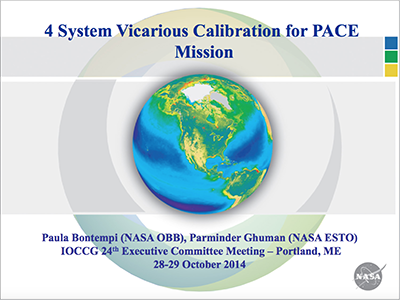
4 System Vicarious Calibration for PACE Mission
Bontempi, P. and Ghuman, P. (16-Jan-15) 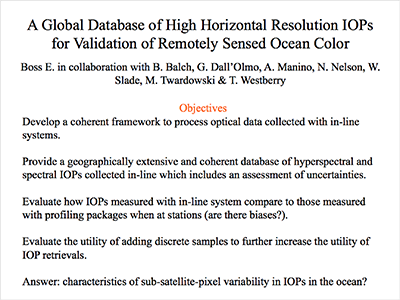
A Global Database of High Horizontal Resolution IOPs for Validation of Remotely Sensed Ocean Color
Boss, E. (14-Jan-15) 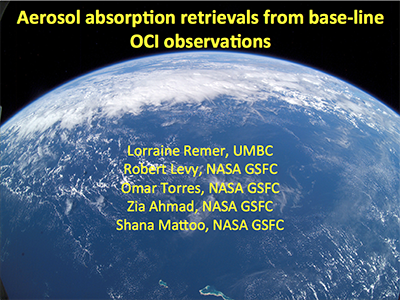
Aerosol Absorption Retrievals from Base-Line OCI Observations: Risk Reduction for Atmospheric Correction of the PACE Mission
Remer, L., Levy, R., Torres, O., Ahmad, Z., and Mattoo, S. (14-Jan-15) 
Atmospheric Correction Discussion : Where We are Today, and Where We Might be in 2.5 Years
Franz, B. (15-Jan-15) 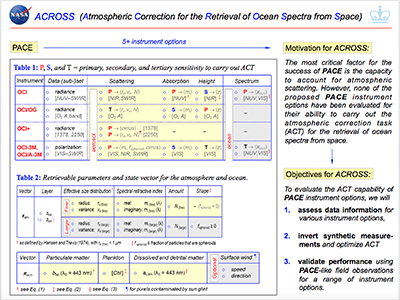
Atmospheric Correction for Retrieval of Ocean Spectra from Space (ACROSS)
Chowdhary, J. (14-Jan-15) 
Atmospheric Correction Over Bright Water Targets with Non-Negligible Radiances in the Near Infrared
Dierssen, H., Randolph, K., Russell, B., and Garaba., S. (14-Jan-15) 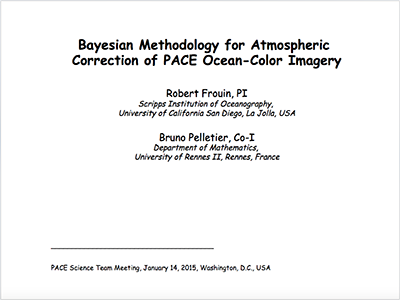
Bayesian Methodology for Atmospheric Correction of PACE Ocean Color
Frouin, R. and Pelletier, B. (14-Jan-15) 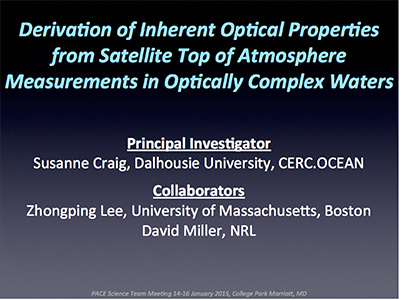
Derivation of Inherent Optical Properties from Satellite Top of Atmosphere Measurements in Optically Complex Waters
Craig, S. (14-Jan-15) 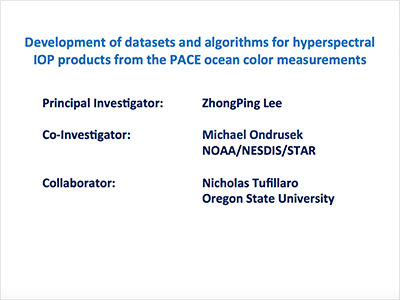
Development of Datasets and Algorithms for Hyperspectral IOP Products from PACE Ocean Color Measurements
Lee, Z. (14-Jan-15) 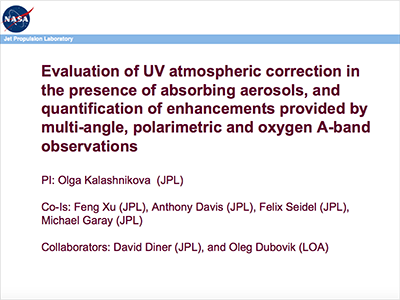
Evaluation of UV Atmospheric Correction in the Presence of Absorbing Aerosols and Quantification of Enhancements Provided by Multiangle Polarimetric and Oxygen A-Band Observations
Kalashnikova, O. (14-Jan-15) 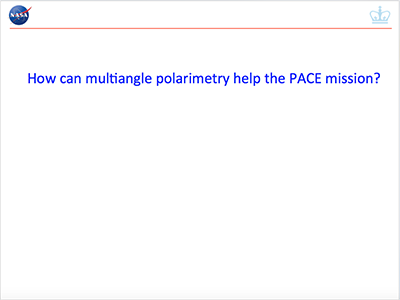
How Can Multiangle Polarimetry Help the PACE Mission?
Chowdhary, J. (16-Jan-15) 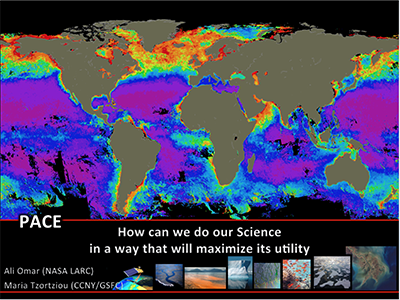
How Can We Do Our Science in a Way that Will Maximize its Utility?
Tzortziou, M. (16-Jan-15) 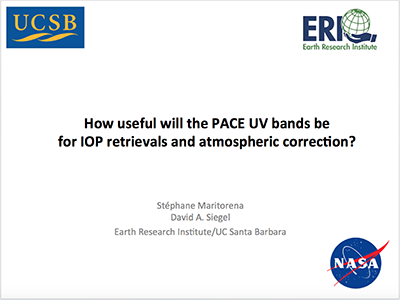
How Useful Will the PACE UV Bands Be for the IOP Retrievals and Atmospheric Correction?
Maritorena, S. and Siegel, D.A. (14-Jan-15) 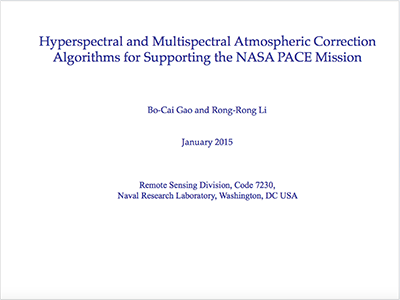
Hyperspectral and Multispectral Atmospheric Correction Algorithms Supporting the NASA PACE Mission
Gao, B-C. (14-Jan-15) 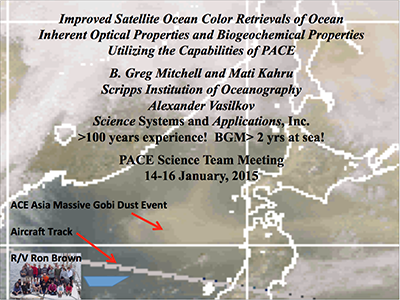
Improved Satellite Ocean Color Retrievals of Ocean Inherent Optical Properties and Biogeochemical Properties Utilizing the Capabilities of PACE
Mitchell, G. and Kahru, M. (14-Jan-15) 
Improving IOP Measurement Uncertainties for PACE Ocean Color Remote Sensing Applications
Sullivan, J., Twardoswski, M. and Moore, T. (14-Jan-15) 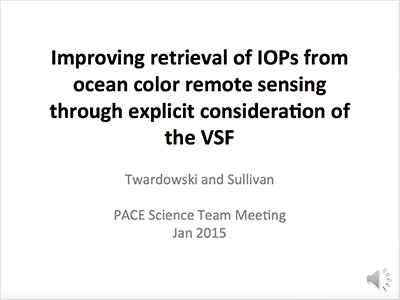
Improving Retrieval of IOPs from Ocean Color Remote Sensing Through Explicit Consideration of the VSF
Twardowski, M. and Sullivan, J. (14-Jan-15) 
Inversion of Rrs to IOPs: Where We are & Where We (Might) Want to Go
Werdell, J. (15-Jan-15) 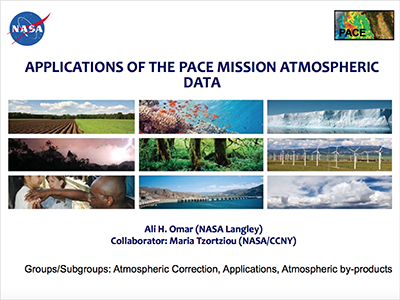
Maximizing the Societal Benefits of PACE Atmospheric Data by Actively Linking the Mission to its Applications
Omar, A. and Tzortziou, M. (14-Jan-15) 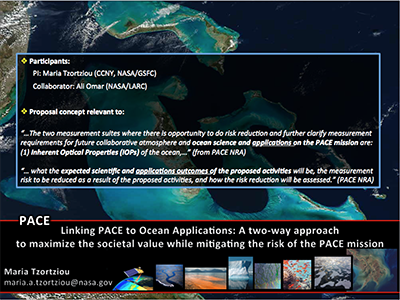
Maximizing the Societal Benefits of PACE IOP Data by Actively Linking the Mission to its Applications
Tzortziou, M. and Omar, A. (14-Jan-15) 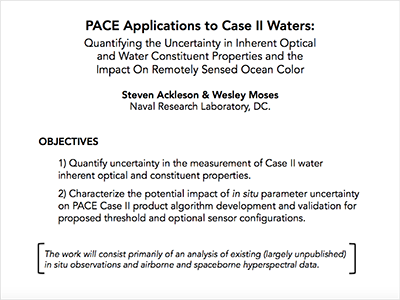
PACE Applications to Case II Waters: Quantifying the Uncertainty in Inherent Optical and Water Constituent Properties and the Impact On Remotely Sensed Ocean Color
Ackleson, S. (14-Jan-15) 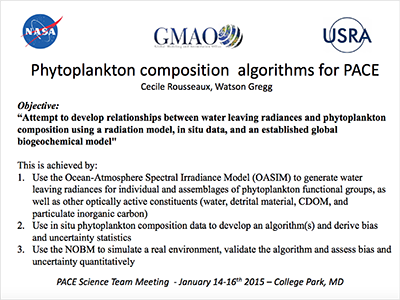
Phytoplankton Composition Algorithms for PACE
Rousseaux, C. and Gregg, W. (14-Jan-15) 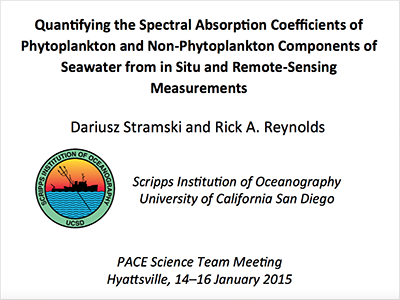
Quantifying the Spectral Absorption Coefficients of Phytoplankton and Non-Phytoplankton Components of Seawater from in Situ and Remote-Sensing Measurements
Stramski, D. and Reynolds, R.A. (14-Jan-15) 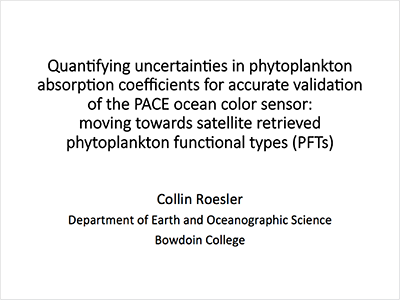
Quantifying Uncertainties in Phytoplankton Absorption Coefficients for Accurate Validation of the PACE Ocean Color Sensor: Moving Towards Satellite Retrieved Phytoplankton Functional Types (PFTs)
Roesler, C. (14-Jan-15) 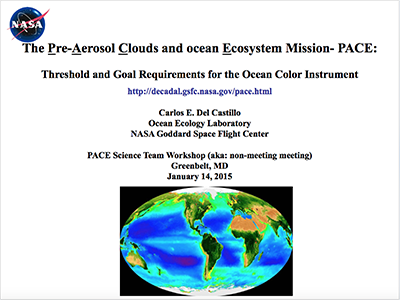
Report from the PACE Science Definition Team
Del Castillo, C. (14-Jan-15) 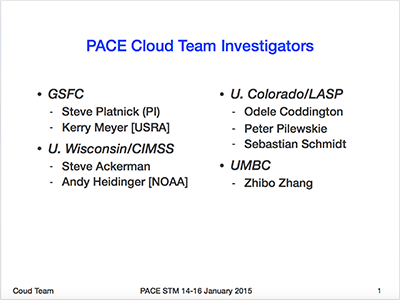
Retrieval Studies in Support of Cloud Property Products from the PACE Ocean Color Imager
Platnick, S. (14-Jan-15) 
Status of PACE mission
Bontempi, P. (14-Jan-15) 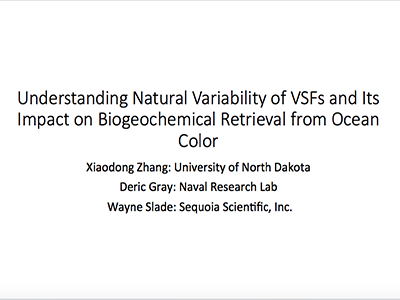
Understanding Natural Variability of VSFs and Its Impact on Biogeochemical Retrieval from Ocean Color
Zhang, X. (14-Jan-15) 2012 Science Definition Team Meeting
March 14-16, 2012Arlington, Virginia USA
Documents (14)
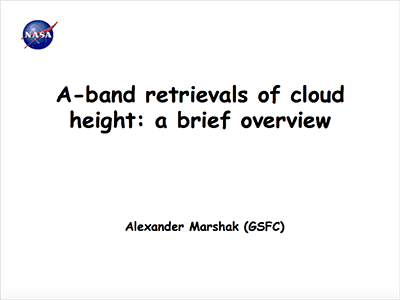
A-band Retrievals of Cloud Height: A Brief Overview
Marshak, A. (14-Mar-12) 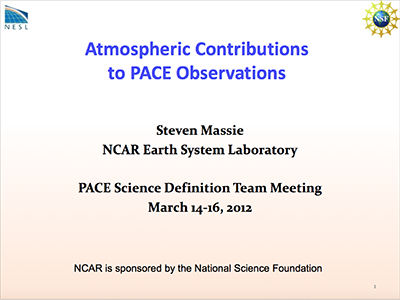
Atmospheric Contributions to PACE Observations
Massie, S. (14-Mar-12) 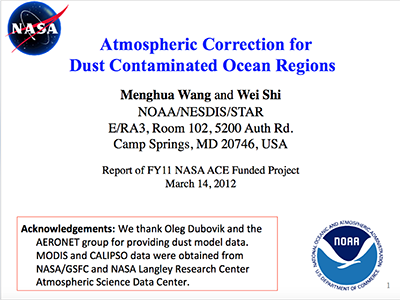
Atmospheric Correction for Dust Contaminated Ocean Regions
Wang, M. and Shi, W. (14-Mar-12) 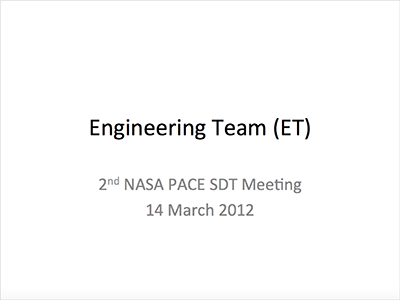
Engineering Team
Wesenberg, R., Wu, C., Smith, J., and Mason, A. (14-Mar-12) 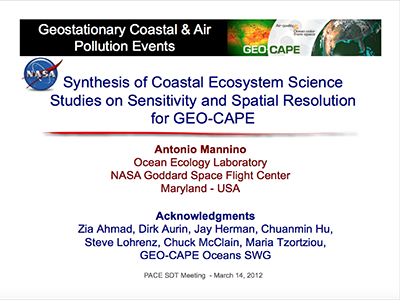
Lessons Learned from GEOCAPE
Del Castillo, C. (14-Mar-12) 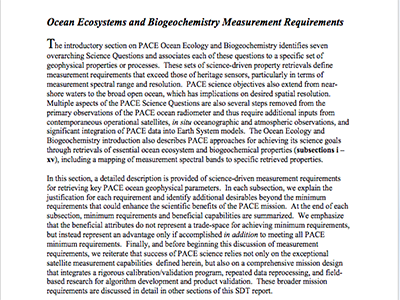
Ocean Ecosystems and Biogeochemistry Measurement Requirements
Behrenfeld, M.J. (14-Mar-12) 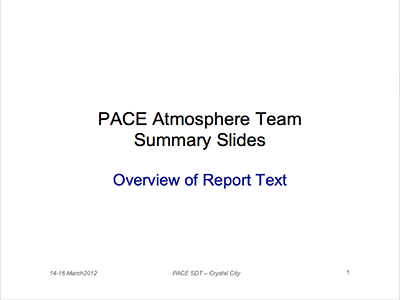
Overiew of Cloud Requirements in Sect. 2.4
Platnick, S. (14-Mar-12) 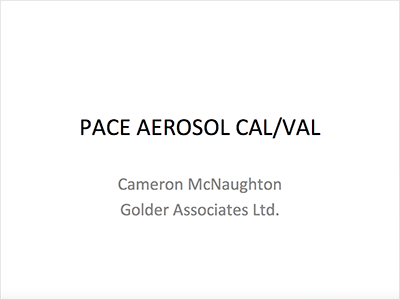
PACE Aerosol Calibration/Validation
McNaughton, C. (14-Mar-12) 
PACE Atmosphere Team Summary
Platnick, S. (14-Mar-12) 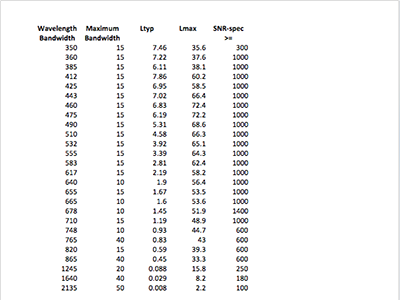
PACE Bands
Boss, E. (14-Mar-12) 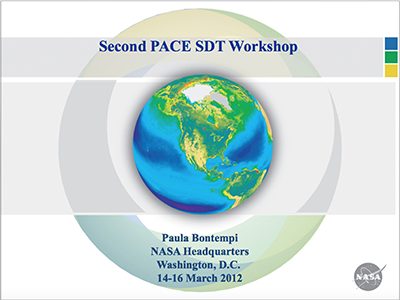
PACE Mission Update
Bontempi, P. (14-Mar-12) 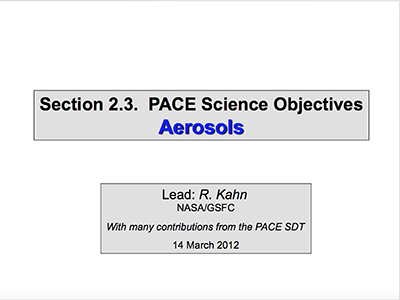
PACE Science Objectives: Aerosols
Kahn, R. (14-Mar-12) 
PACE Sensitivity Studies
Frouin, R. (14-Mar-12) 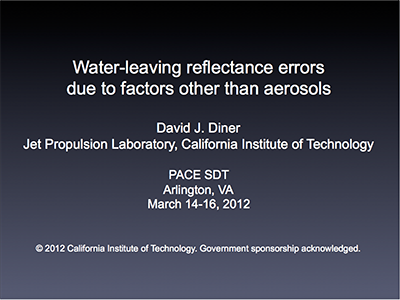
Water-leaving Reflectance Errors Due to Factors Other than Aerosols
Diner, D.J. (14-Mar-12) 2011 Science Definition Team Meeting
November 16-18, 2011Arlington, Virginia USA
Documents (14)
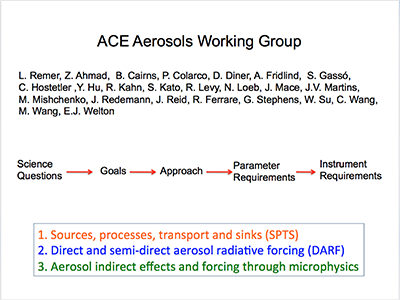
ACE Aerosol STM
Kahn, R. (17-Nov-11) 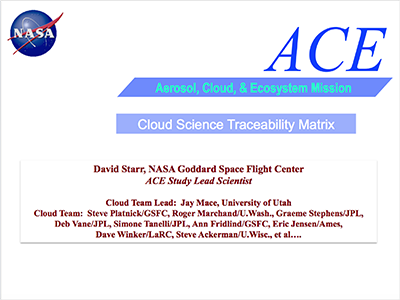
ACE Cloud STM
Starr, D. (17-Nov-11) 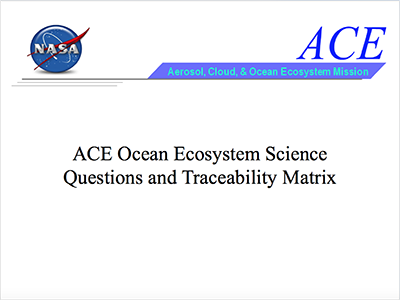
Aerosol, Cloud, ocean Ecosystem (ACE) Mission Ocean Ecosystem Science Traceability Matrix (STM)
Behrenfeld, M. (17-Nov-11) 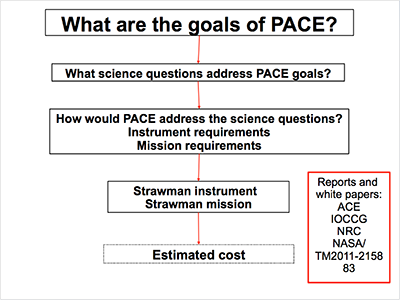
Group Discussion of Ocean Color and Aerosol/Cloud Science Requirements - Ocean Ecosystem
Del Castillo, C. (17-Nov-11) 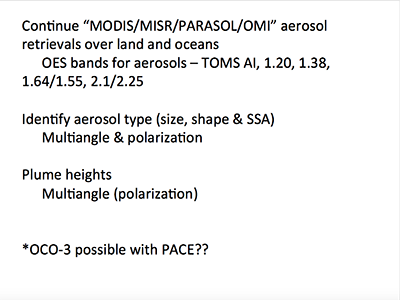
Group Discussion of Ocean Color and Aerosol/Cloud Science Requirements - Ocean/Atmosphere Science and Ocean Color Atmospheric Correction
Del Castillo, C. (17-Nov-11) 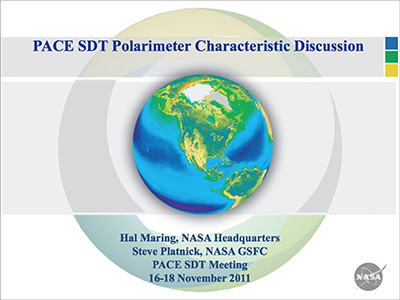
Group Discussion of Ocean Color and Aerosol/Cloud Science Requirements - Polarimetry
Maring, H. (17-Nov-11) 
Introduction of the PACE SDT by SDT/Meeting Goals and Objectives
Bontempi, P., Maring, H., and Turner, W. (16-Nov-11) 
IOCCG Level 1 Requirements Report
Meister, G. (17-Nov-11) 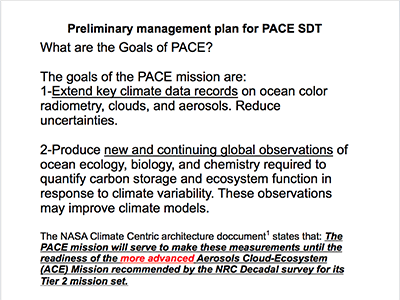
Organization of the SDT Science and Tasks
Del Castillo, C., Maring., H., and Platnick, S. (16-Nov-11) 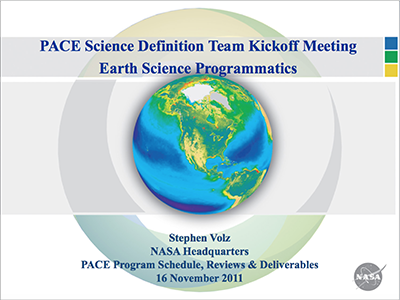
PACE Mission and Flight Programs/Schedules, Reviews and Deliverables
Volz, S. (16-Nov-11) 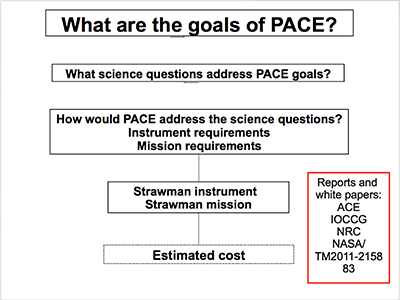
Summary of Action Items and Next Steps for SDT and Report
Del Castillo, C. (18-Nov-11) 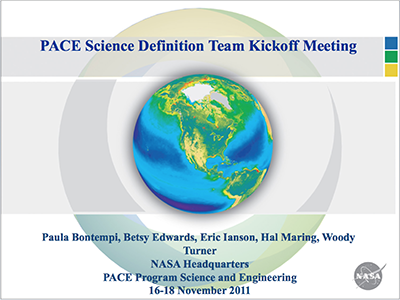
Tasking of the PACE SDT and Production of a Science and Requirements Report
Bontempi, P., Maring, H., and Turner, W. (16-Nov-11) 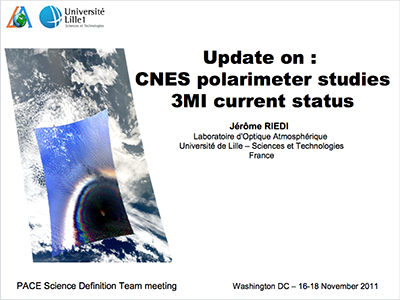
Update on CNES Planning/Phase 0 Polarimeter Study
Riedi, J. (16-Nov-11) 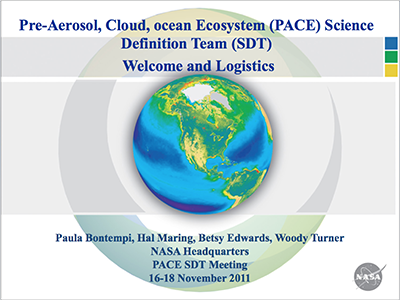
Welcome and Logistics
Bontempi, P., Maring, H., Edwards, B., and Turner, W. (16-Nov-11) 
